Vanta cracked the code on making compliance less painful, and we all noticed. But as we move through 2025, the game has changed. Costs are creeping up. Flexibility now sits behind paywalls. Custom fits? Rare.
As founders building fast, we don’t have time for clunky dashboards or endless back-and-forth with auditors. We need platforms that automate the grunt work, play nice with our stacks, and don’t break the budget.
Whether you're a startup racing to SOC 2 or an enterprise scaling across ISO 27001 and HIPAA, there are tools here that fit your modern security workflows.
We’ve reviewed each platform in depth so you can compare competitors and find the best alternative that fits your business without sitting through 15 demos.
This comprehensive guide ranks the top 15 Vanta competitors based on automation, framework coverage, pricing, integrations, audit readiness, and user experience.
Let’s dive right in.
What is Vanta?
Vanta is a platform that builds security compliance software.
Most teams use it to get SOC 2 ready fast. It connects to your systems, tracks security controls, and automates evidence collection and management.
In 2025, it’s still the go-to for early-stage startups chasing their first few deals.
SOC 2 and security compliance automation simplified
Vanta made compliance less painful. Instead of spreadsheets and screenshots, it integrates with AWS, Google Workspace, GitHub, and your HR system. From there, it runs continuous checks, flags issues, and organizes everything you need for an audit. You stay on track without hiring a compliance manager.
Here’s what you get:
- Monitoring: Real-time tracking of security controls like MFA, endpoint coverage, and access reviews.
- Integrations: 75+ native ones. Most startups can connect their full stack in a day.
- Audit readiness: Built-in policy templates, pre-mapped controls, and shared auditor access. No emailing PDFs back and forth.
- Trust page: A public-facing page to show prospects your security posture. Saves time during sales.
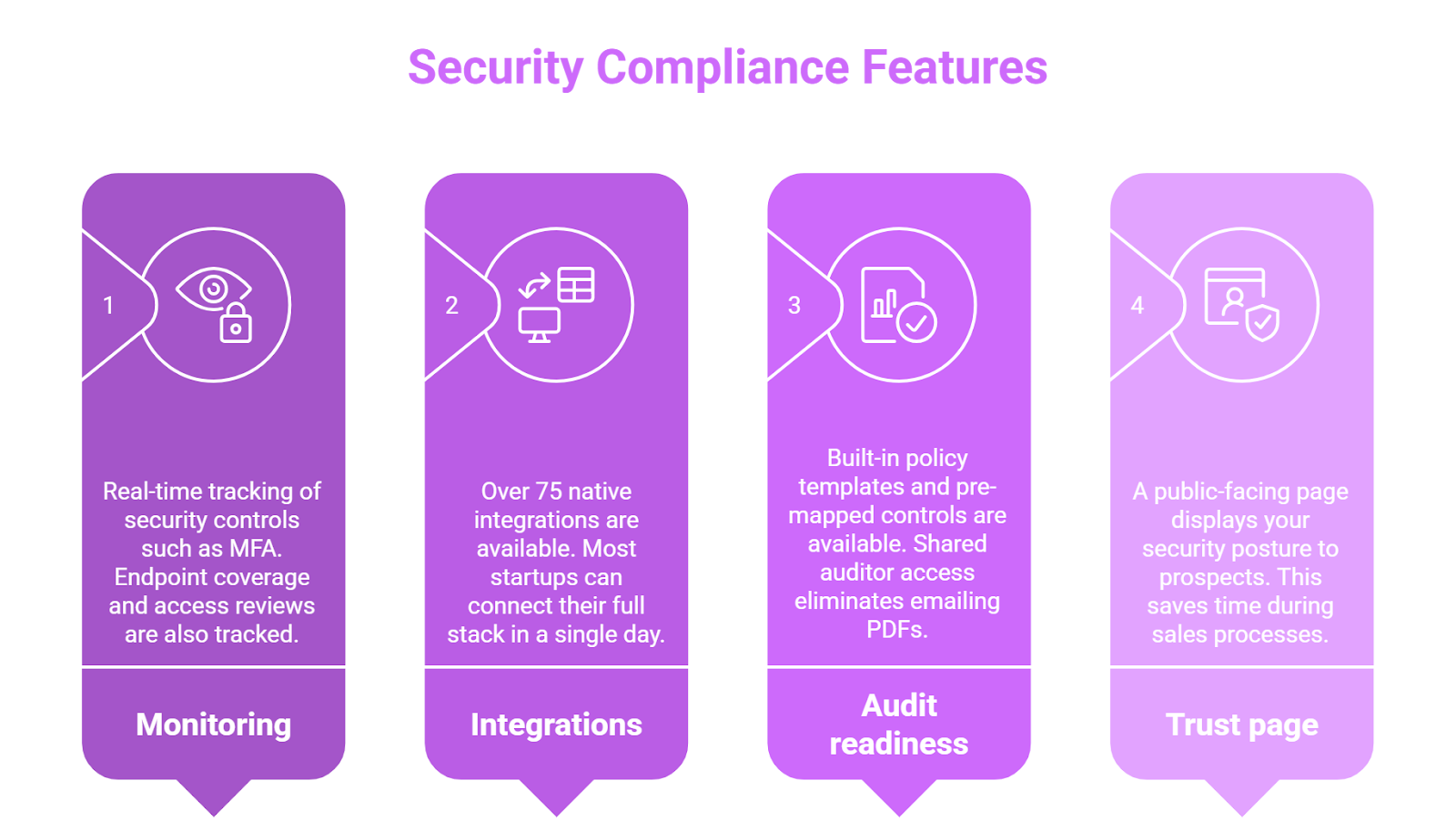
2025 pricing snapshot
Pricing isn’t public, but here’s what we’ve seen:
- Starts at $8,000/year for SOC 2 only
- Jumps to $10,000–$12,000/year with ISO 27001 or HIPAA
- Costs scale with team size and frameworks
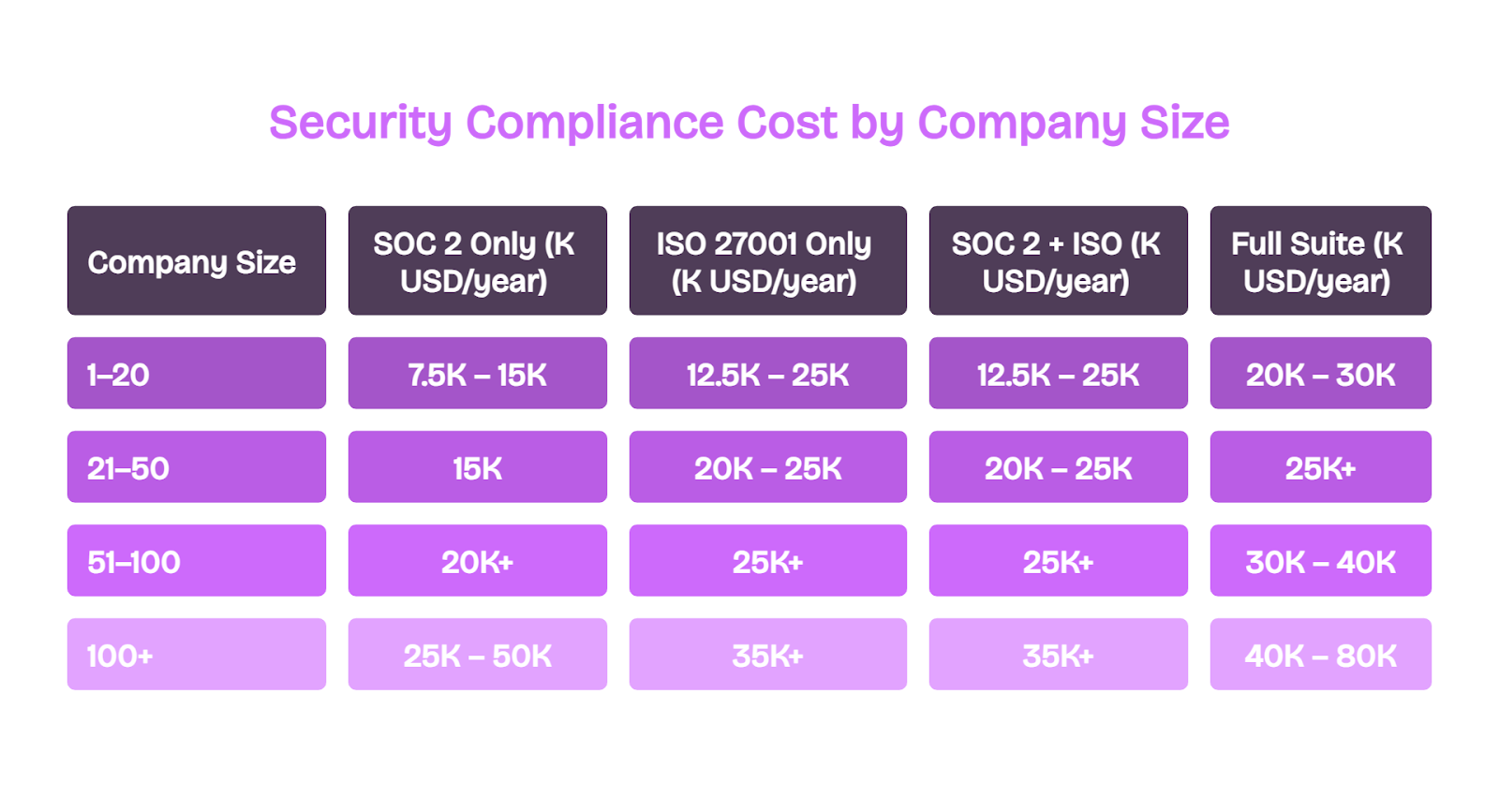
Vanta quotes are based on headcount and needs. Most teams end up negotiating. Once you grow, it gets expensive.
Market perception and user ratings
G2 rates Vanta a solid 4.6/5, based on over 500 reviews, which shows great promise.
Capterra gives Vanta a 4.5/5, with strong feedback on ease of use.
Teams appreciate how quickly they can get set up.
The main complaints? Rigid workflows and support that don’t always scale, as highlighted here in one of many customer reviews.
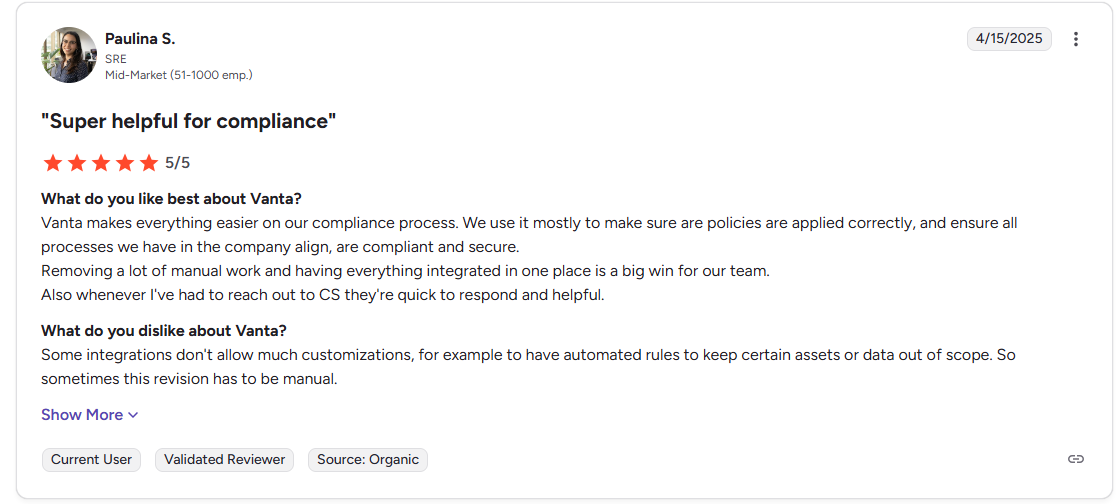
Why Look for Vanta Alternatives?
Vanta works well for small teams chasing SOC 2. But it hits limits fast once your needs change. That’s why many teams start with Vanta, then outgrow it. Let’s look at a few reasons why.
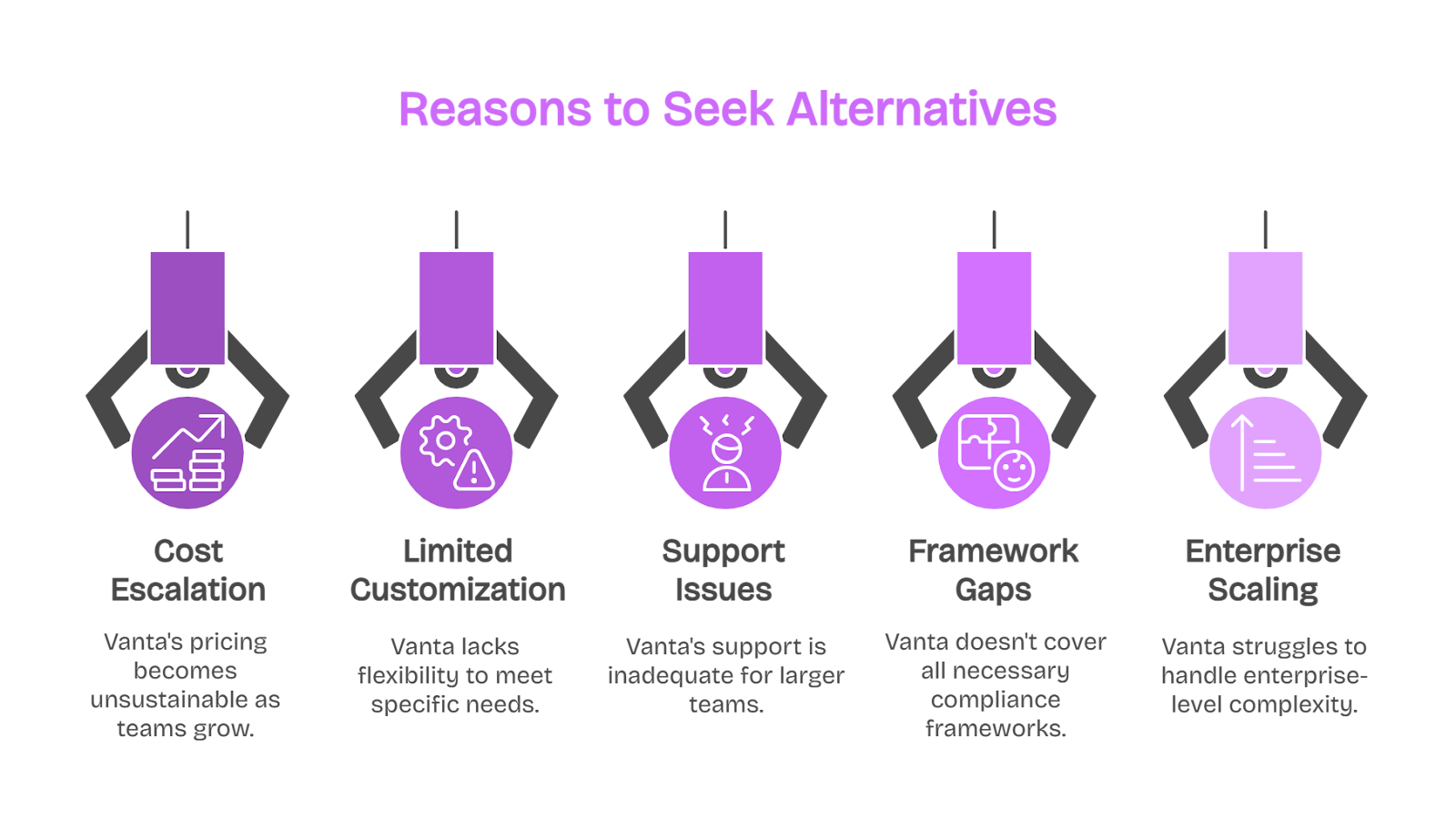
Pricing rigidity and cost scaling
You pay more as your team grows. Adding frameworks like HIPAA or ISO 27001 costs extra. Vanta doesn’t publish prices, so you’re often guessing until the sales call. Budget creep is common.
Vanta is a better tool unless you’re scaling and you can’t handle the rising prices. Even if you decide to take your business elsewhere, the switching costs might haunt you for a while.
Limited customization and extensibility
Vanta is built to be “plug-and-play”. That’s great at first. But once you want custom workflows, deeper control mappings, or cross-team tasks, you hit walls. It’s not built for flexibility.
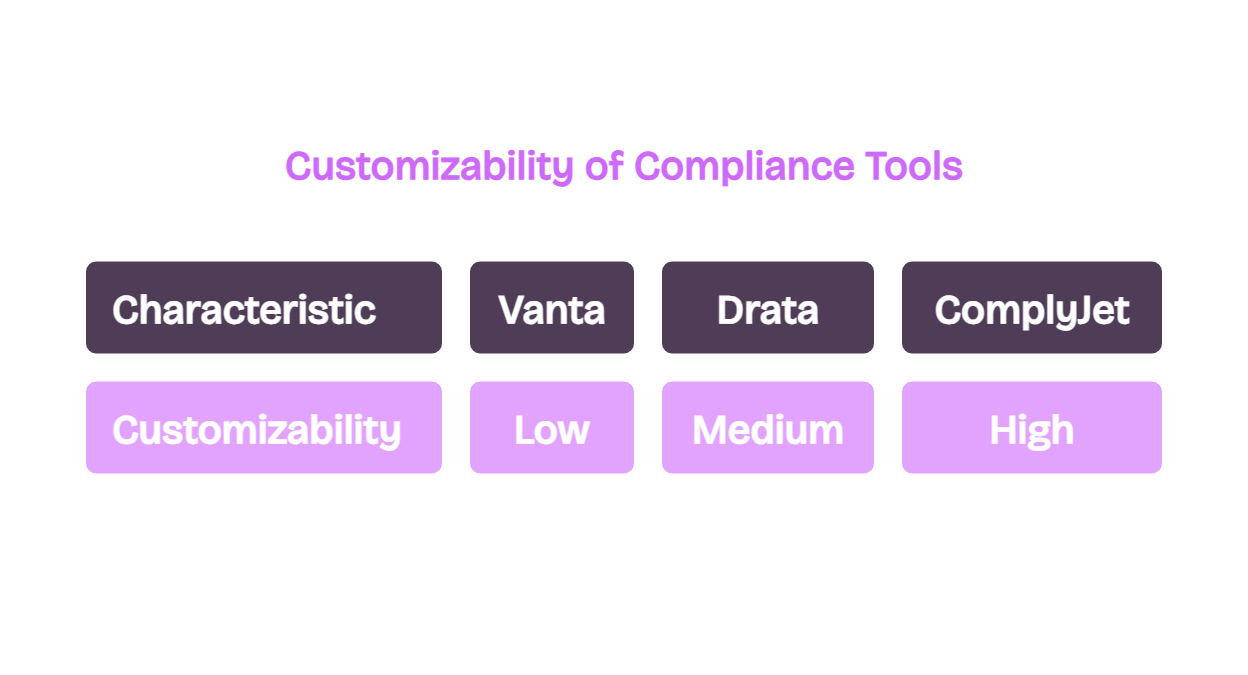
Customer support and onboarding issues
Some teams report slow onboarding. Others mention limited help during audits. If you're not a high-paying customer, support can feel generic or delayed.
“We felt left in the dark once onboarding ended. It’s tough to get real-time help unless you're on the premium plan.
– Series A Fintech CTO
Framework limitations for ISO 27001, HIPAA, etc.
SOC 2 is where Vanta shines. For ISO 27001 or HIPAA, the tooling feels less mature. Controls can feel too generic, and the audit paths aren’t as polished as competitors like Drata or Sprinto.
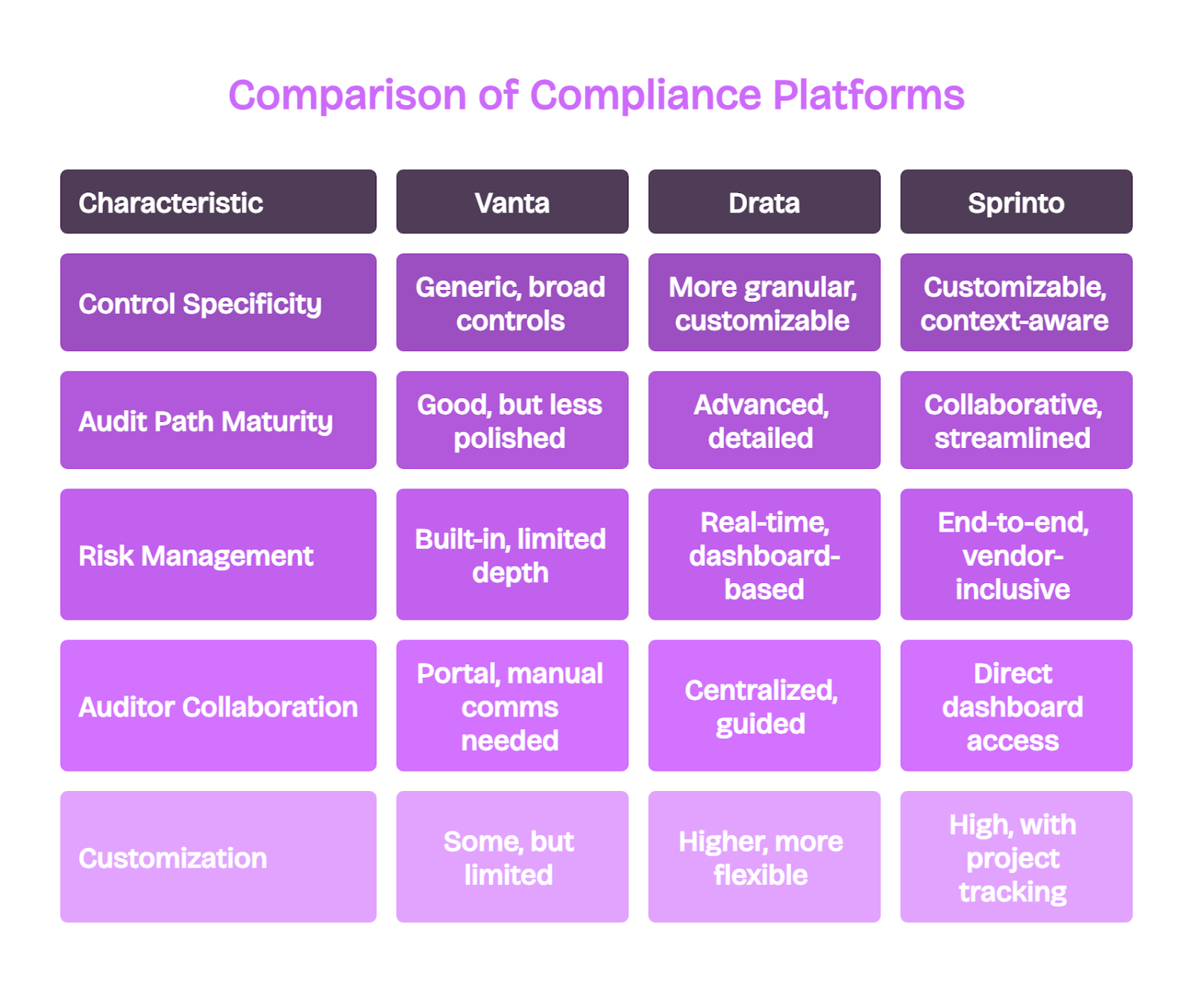
Startup vs enterprise fit mismatch
Vanta was made for startups. Once you grow past 50 people or operate in multiple regions, you may need more. Things like risk registers, advanced access controls, or multi-entity audits aren’t fully there.
If you're scaling fast or if compliance is becoming a core function, it’s worth looking at alternatives.
When Does It Make Sense to Switch?
You start with SOC 2. That gets you through your first few audits. But then ISO 27001 shows up in enterprise contracts. Maybe you’re expanding into healthcare and need HIPAA or handling payments and bumping into PCI-DSS.
Now you're managing multiple frameworks. And Vanta, which was once smooth, starts to feel like a tight jacket.
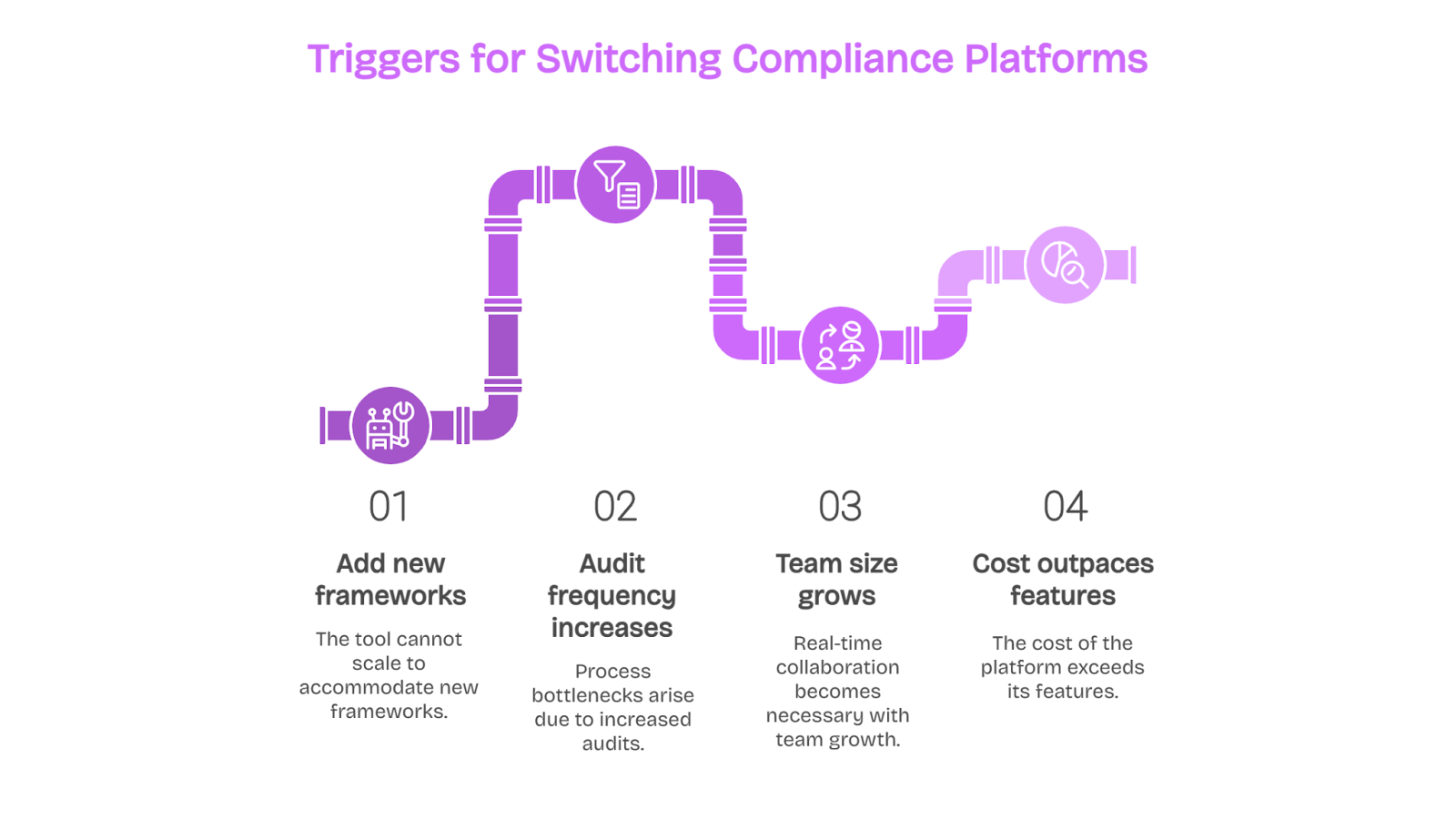
Audit cycles also get tighter. What used to be annual is now quarterly. You need controls mapped more granularly, with real-time status updates across teams. That’s hard to do if your tool isn’t flexible.
We’ve also seen teams hit a wall when trying to automate more of the process. Custom workflows. Deeper integrations. Alerting is tied to real-time risk signals. Vanta wasn’t built for that.
Once the price tag crosses a certain threshold, we all start asking the same question: Are we getting what we pay for?
If you're scaling fast or juggling multiple frameworks, switching gives you more than just features. It gives you control. The right platform helps you operationalize compliance without growing headcount or blowing the budget.
For those of us running lean and moving fast, that’s survival.
TL;DR: Summary Table
Here’s our TL;DR comparison table to zero in on the best Vanta alternatives by pricing, feature set, and supported compliance frameworks. Whether you're choosing for speed, cost, or coverage, the shortlist starts here.
Key Comparison Criteria and why it matters
When we look for a Vanta alternative, we’re doing more than just chasing a nicer UI or a lower price. We’re replacing a core system. So we measure against the six criteria that actually move the needle in audits and scale. Make a note of these for choosing what’s best for you.
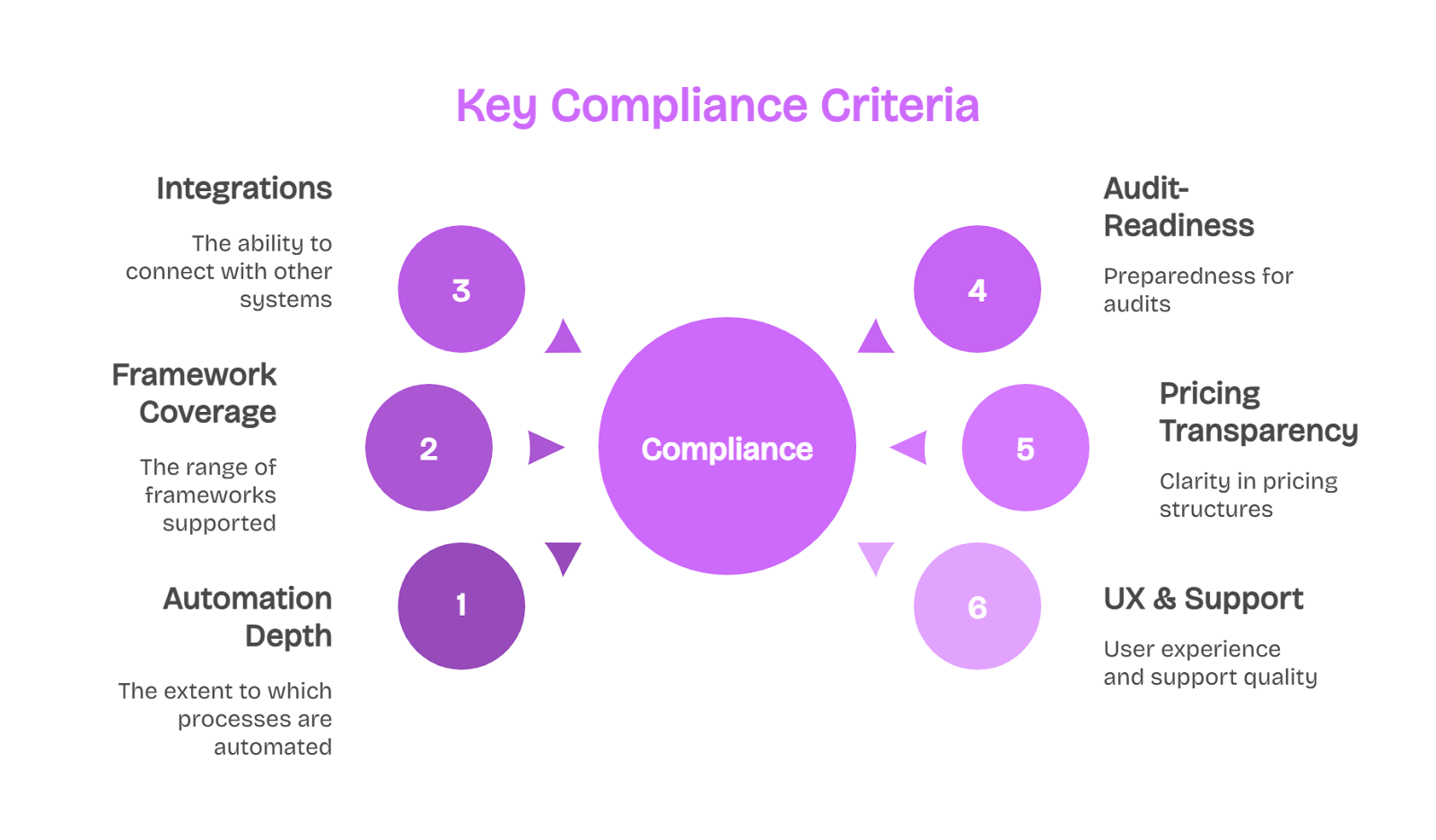
1. Automation Depth
This tells us how much of the grunt work gets done without us touching it.
If we’re still tracking things in spreadsheets, something’s wrong. The right tool pulls logs, checks controls, and flags gaps before auditors do. That saves weeks.
What to check: Can it pull real-time control data from AWS? Does it track access rights on its own? Does it close the loop, or does it leave follow-up on us?
2. Framework Coverage
Most teams start with SOC 2. Few stop there.
If the platform can’t support ISO 27001 or HIPAA when we need them, we’ll be switching again. That’s costly.
What to check: Look for pre-mapped controls, cross-framework alignment, and easy toggling between standards.
3. Integrations
Integrations are how the platform sees what’s happening across our stack.
No integrations? No automation. We end up uploading screenshots manually and validating things by hand. That’s not scalable.
What to check: Does it sync with Okta, Jira, Gusto, AWS? Is it pulling live data or just storing static files?
4. Audit-Readiness Features
Good platforms prepare us for audits before they happen.
We need audit dashboards, task lists, and checklists that don't break under pressure. And when auditors show up, we should be able to drop them into a portal, not a Dropbox folder.
What to check: Can we customize templates? Does it let us run mock audits internally?
5. Pricing Transparency
Some tools pitch $3K/year, then tack on charges for every new user, framework, or integration. That’s how budgets spiral.
We prefer seeing the full picture up front.
What to check: Published pricing, tier breakdowns, and the ability to test-drive without sales calls.
6. User Experience and Support
Even the best platform fails if the team avoids using it.
We’ve seen compliance tools that feel like spreadsheets duct-taped together. That kills adoption.
What to check: Clear UI, fast onboarding, live chat, and real humans when we hit audit week.
The 2025 Leaderboard: Top 15 Vanta Alternatives
We’ve broken down the top Vanta alternatives that deliver when it counts. Real workflows. Real use cases. Real tradeoffs. Use this to pick the right fit for your team’s growth stage and compliance goals.
Drata – Best for Compliance Ops at Scale
Automation Depth
Strong in continuous control monitoring. Auto-checks, change alerts, and evidence tagging work well across large teams.
Framework Coverage
SOC 2, ISO 27001, HIPAA, PCI, GDPR, and FedRAMP. The unified control library helps reduce duplication across multiple frameworks.
Integrations
150+ integrations. Covers all major cloud, identity, dev tools, and endpoint protection systems.
Audit-Readiness
Centralized audit management, real-time health checks, and role-based access for internal and external auditors.
Pricing Transparency
Starts at $9,000/year and extends up to $100,000/year based on your company size. Extra charges for additional frameworks and users. Tiered plans.
UX & Support
Mature product. Better for technical teams. Support is solid, but onboarding has a learning curve. Users expect the incorporation of AI features, as highlighted in this verified customer review.
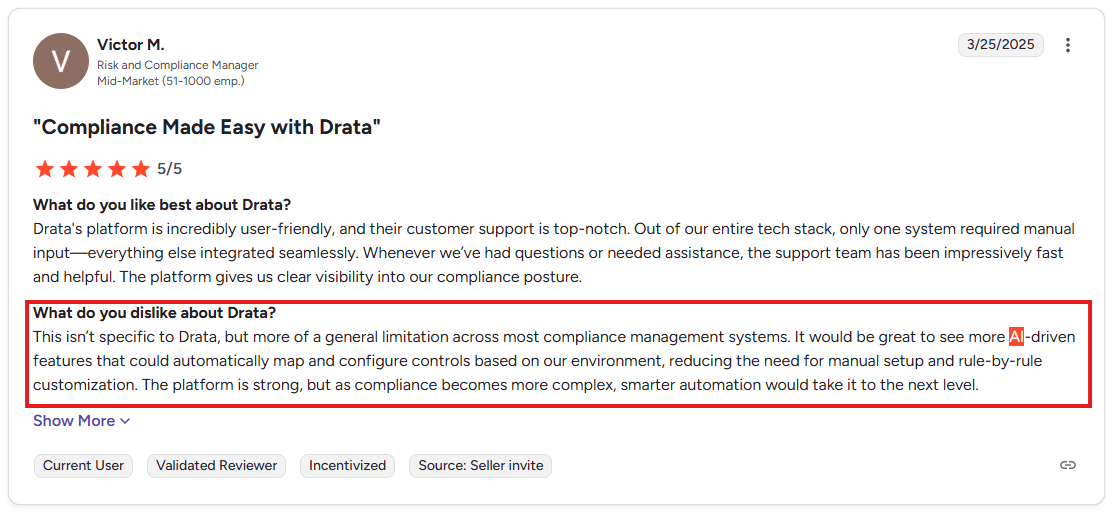
Here’s the pros and cons overview that sums up everything Drata users have to say:
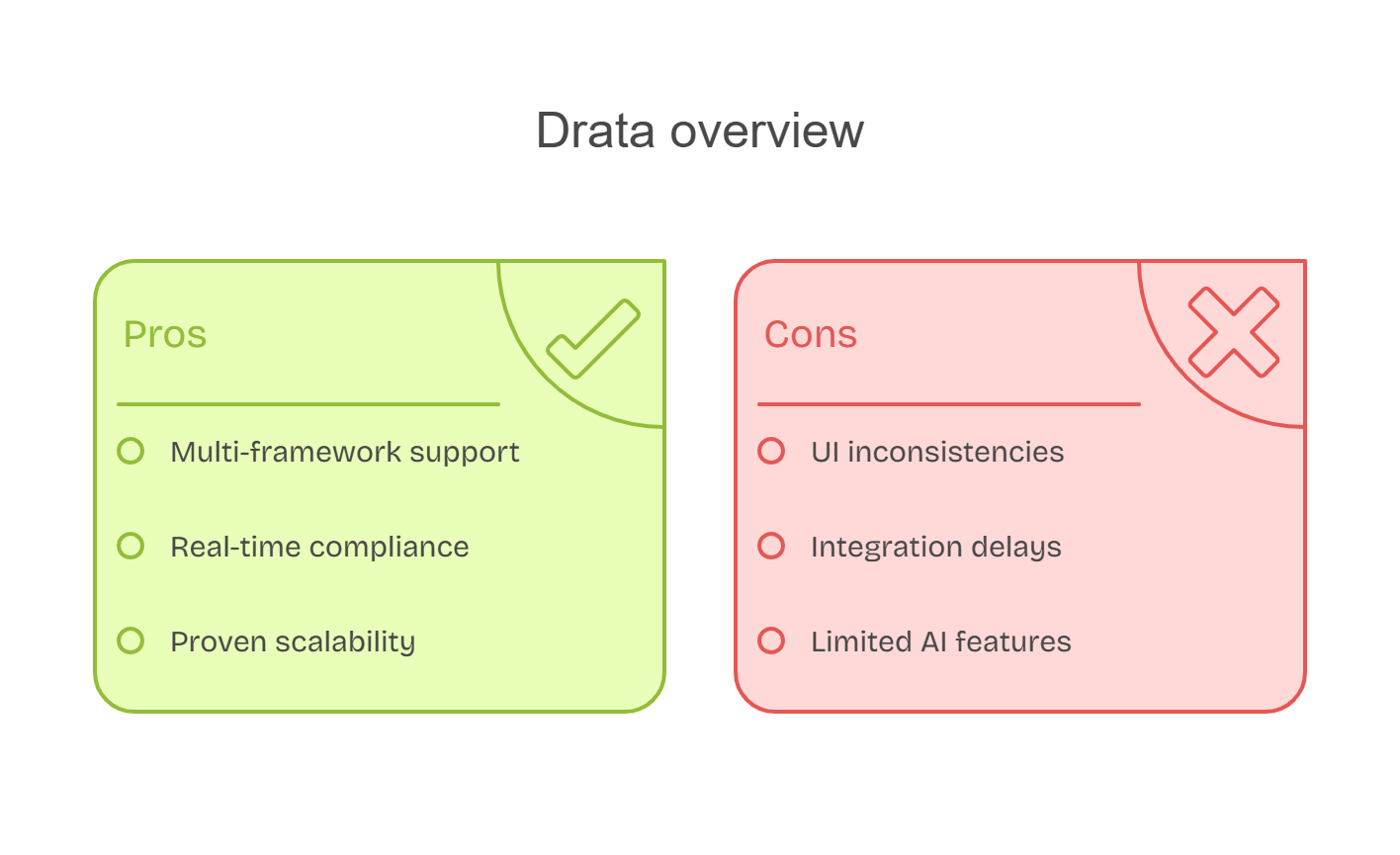
Best Fit Use Case
Mid-market or enterprise compliance teams with dedicated ops leads and a need to unify frameworks.
Drata vs Vanta
Drata scales better for larger teams juggling multiple standards. Vanta remains better for early-stage teams with narrow compliance scope.
You need Drata if:
You’re expanding into multiple frameworks and want deep integrations that won’t require manual upkeep.
ComplyJet – Best for Speed and Simplicity at the Early Stage
Automation Depth
ComplyJet automates over 90% of control monitoring from day one. That includes log collection, user access reviews, cloud configuration checks, and policy enforcement. We built it to avoid spreadsheet chaos.
Framework Coverage
Out of the box, ComplyJet supports SOC 2 and ISO 27001. Additional frameworks like HIPAA, PCI DSS, and GDPR are in the roadmap with early-access options. Our goal is full multi-framework alignment without rebuilding workflows.
Integrations
Native integrations with AWS, Azure, Google Workspace, GitHub, Okta, Jira, and Notion. Real-time syncing for evidence collection, control validation, and remediation tracking. We prioritized integrations that founders use.
Audit-Readiness
You get auditor-ready templates, auto-generated policy libraries, and guided workflows to close gaps fast. There's a dedicated portal for external auditors to access exactly what they need. No back-and-forth over email.
Pricing Transparency
Starts at $4999/year. That includes SOC 2 or HIPAA or ISO 27001 with 100+ core integrations with AI features, policy library, and onboarding support. ComplyJet does not charge extra for every new framework or user. The pricing is flat, upfront, and startup-friendly.
ComplyJet also offers a free trial for you to make an informed decision, while most of the competitors shy away.
UX & Support
ComplyJet is built for speed. The UI is clean and action-driven. No tabs buried inside tabs. Live onboarding, Slack-based support, and 24-hour turnaround for compliance blockers.

Best Fit Use Case
Seed to Series B SaaS teams that need to go live with SOC 2 quickly, without hiring a compliance lead.
ComplyJet vs Vanta
Vanta offers wider framework coverage and broader brand awareness. ComplyJet wins on speed, price clarity, and founder-first UX. If we were starting fresh and needed SOC 2 yesterday, we’d go with ComplyJet.
You need ComplyJet if:
You’re an early-stage company and need to hit SOC 2 Type I fast, and you care about cost, control, and clarity.
Sprinto – Best for Fast-Growth SaaS Compliance
Automation Depth
Sprinto gets teams audit-ready fast. Auto-collects evidence, tracks access, and flags control gaps without manual chasing.
Framework Coverage
SOC 2, ISO 27001, HIPAA, PCI, GDPR, and more. Built to support multiple frameworks concurrently without duplicating effort.
Integrations
200+ direct integrations with infra, HRIS, and ticketing tools. API access is available for edge cases.
Audit-Readiness
Strong audit dashboard, evidence timelines, and partner network. Certified auditors are included depending on the plan.
Pricing Transparency
Request-based pricing model based on frameworks and headcount. The prices range from $7,000-$50,000+ annually
UX & Support
Fast to implement. Clean UI and a support team that’s tuned for speed. Many users prefer the integrations to be improved and expect increased customization, as highlighted by this verified customer.
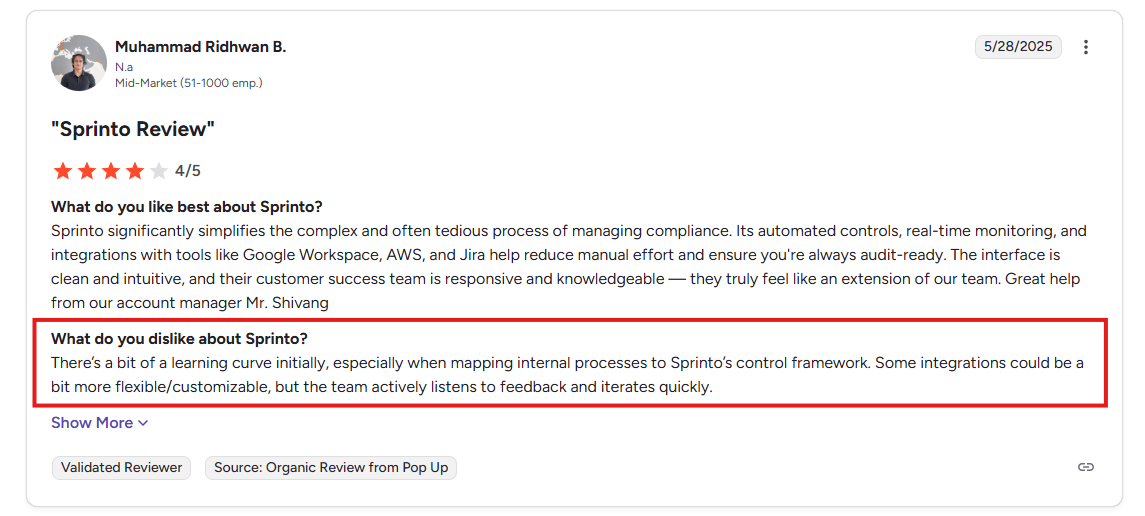
Here’s the pros and cons overview that sums up everything Sprinto users have to say.
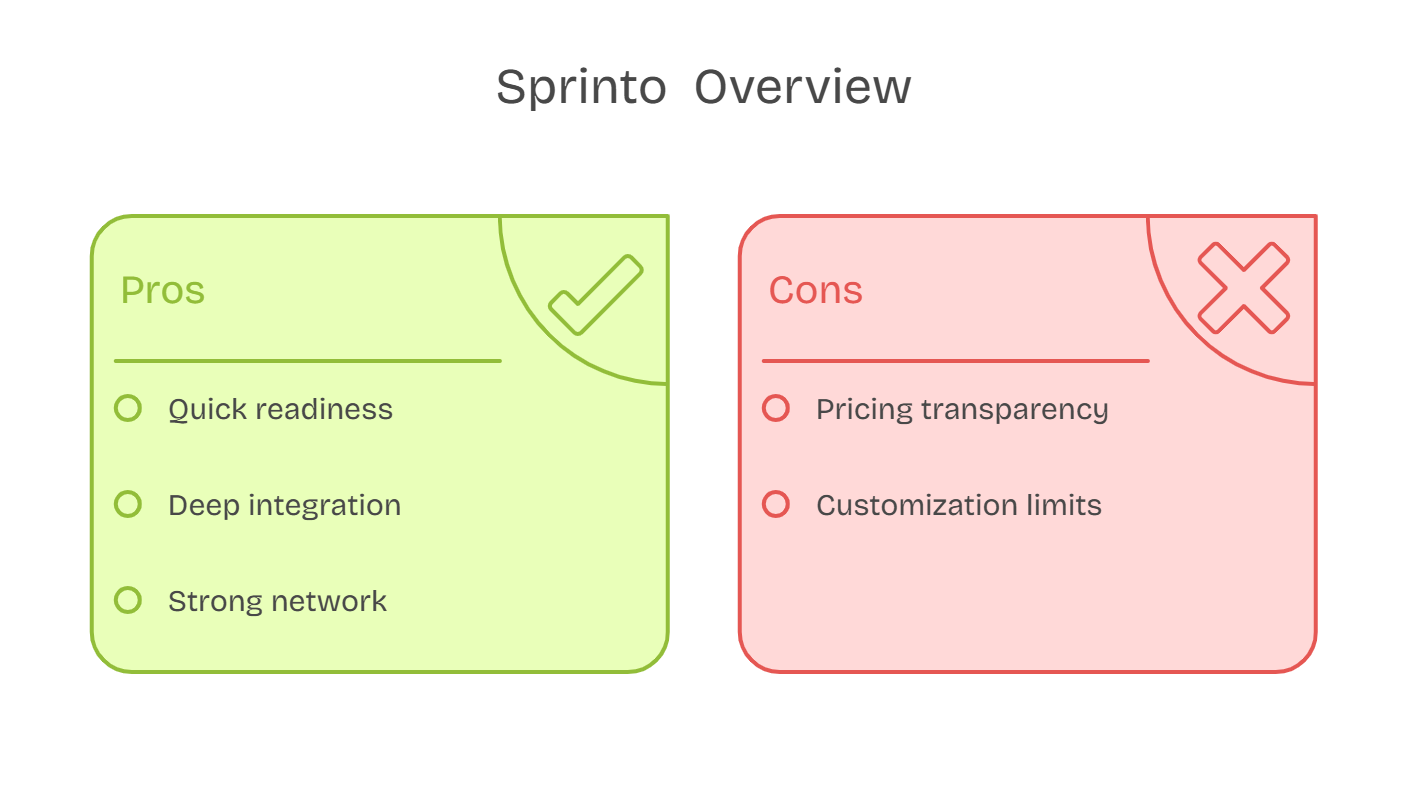
Best Fit Use Case
Startups or growth-stage SaaS companies aiming to close enterprise deals fast with SOC 2 or ISO as a blocker.
Sprinto vs Vanta
Sprinto moves faster on implementation and evidence handling. Vanta is simpler but slower for audit timelines and less flexible when scaling frameworks.
You need Sprinto if:
You want fast SOC 2 automation without the overhead and built for lean teams with minimal margin for delays.
Thoropass – Best for Compliance Teams Who Want Built-in Audit Help
Automation Depth
Covers basic evidence automation and alerting. Not as granular as others, but pairs this with embedded audit support. Their compliance experts plug the gaps that software alone can’t handle.
Framework Coverage
Strong SOC 2 and ISO 27001 coverage. Supports HIPAA, GDPR, PCI, and HITRUST. FedRAMP is in progress. Framework mapping is handled partly by human consultants.
Integrations
Core integrations include AWS, Azure, Okta, Google Workspace, and GitHub. Not as deep as Drata or Scrut, but enough for mid-size stacks.
Audit-Readiness
Audit delivery is the core pitch. Access to in-house auditors who handle readiness and conduct the audit under one roof. Audit reports tend to land faster here.
Pricing Transparency
Packages vary by team size, frameworks, and whether audits are bundled. Expect to talk to sales.
UX & Support
UX is clean but with a few anomalies that users don’t mind and are fixed consistently. Onboarding is guided, and support teams are strong on compliance logic, not just tech support.
Automation features are reported to get the work done, although users feel the need for extending them to more processes, as highlighted by this verified Thoropass user.
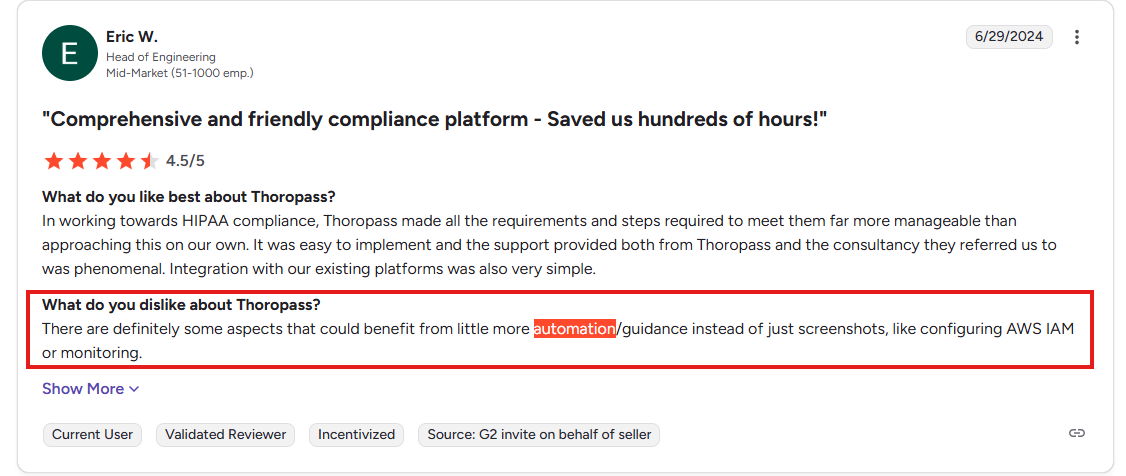
Here’s the pros and cons overview that sums up everything the other Thoropass users have to say:
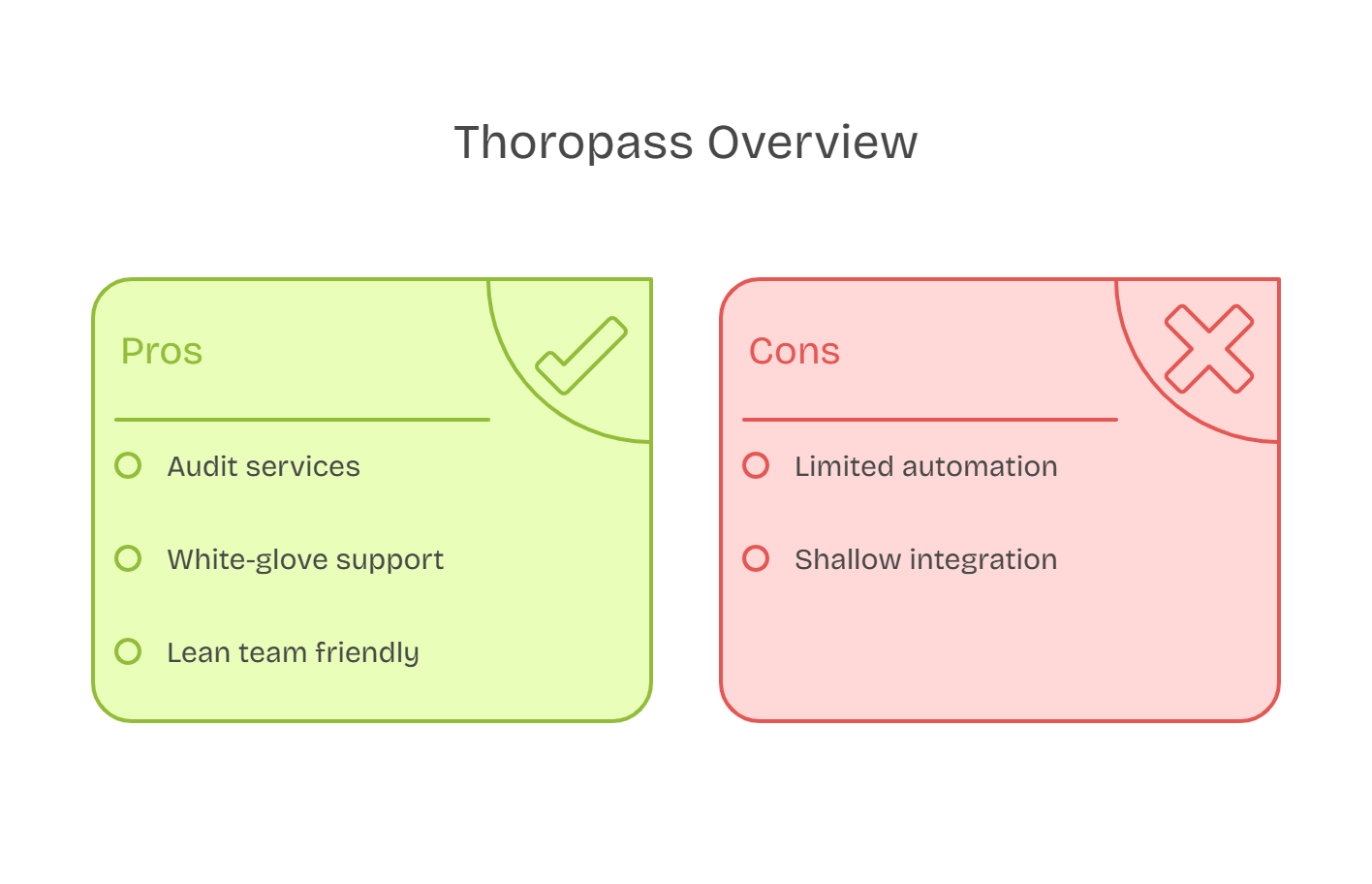
Best Fit Use Case
Small to mid-size teams that want compliance and audits managed together without juggling third parties.
Thoropass vs Vanta
Vanta gives you a checklist. Thoropass gives you a coach and a referee. It’s better if you want support baked into the process, not just a dashboard.
You need Thoropass if:
You want audit support and expert guidance without hiring consultants.
Scytale – Best for Customizable Controls and Growing Ops Teams
Automation Depth
Automates evidence collection, risk tracking, and continuous monitoring. Offers decent control mapping but still relies on manual work in complex environments.
Framework Coverage
SOC 2, ISO 27001, HIPAA, PCI DSS, GDPR, and CCPA supported. Also includes regional frameworks for privacy and fintech-specific variants.
Integrations
30+ integrations including cloud providers, identity tools, and ticketing systems. APIs are available for less common use cases.
Audit-Readiness
Includes customizable audit checklists, task delegation, and policy creation. Works well when workflows need tailoring.
Pricing Transparency
Pricing is quote-based. No self-serve plans. The cost scales with frameworks and team complexity.
UX & Support
The interface is functional and improving. The best experience comes with dedicated CSM guidance. Support is responsive and tailored.
Users report some minor quirks in the UX as highlighted by this verified Scytale user.
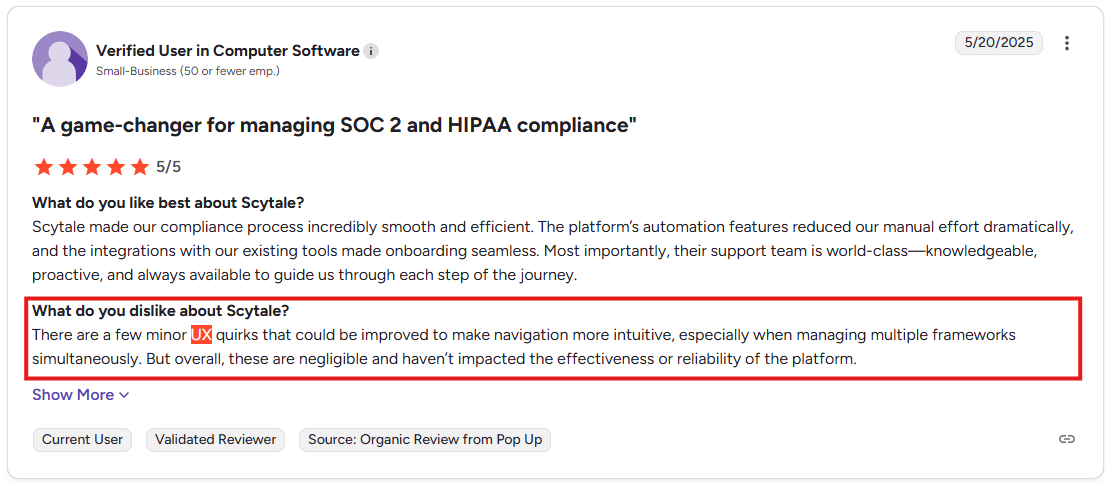
Here’s the pros and cons overview that sums up everything that the other users have to say:
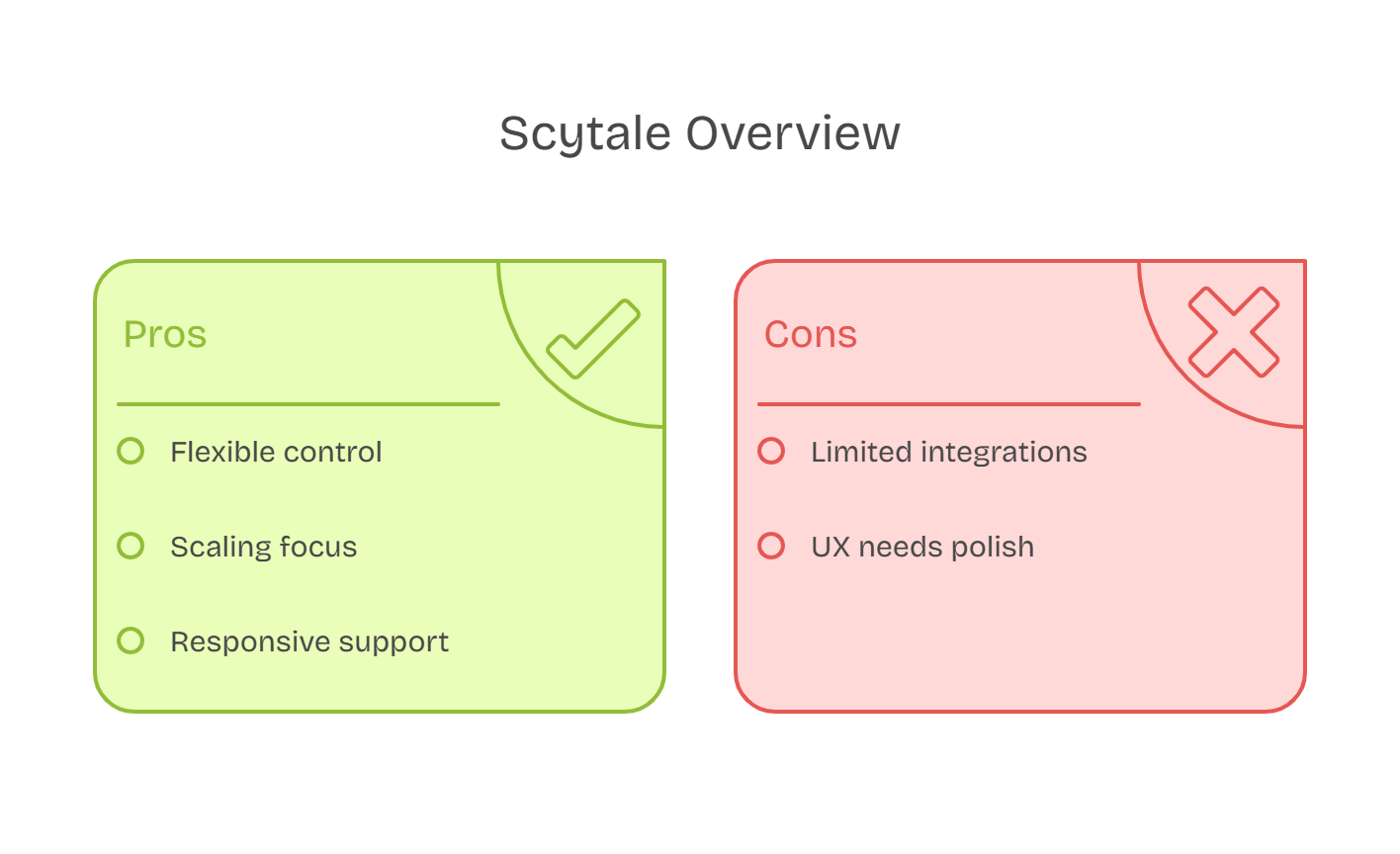
Best Fit Use Case
Teams that need to adapt frameworks to nuanced processes, especially in finance or healthcare.
Scytale vs Vanta
Scytale is slower to set up but offers more flexibility. Vanta works better if you want speed and simplicity. Scytale wins when internal processes don't fit cookie-cutter workflows.
You need Scytale if:
You’re in a regulated market and need strong HIPAA, GDPR, and ISO coverage.
Secureframe – Best for Security-Minded Teams Needing Audit-Grade Evidence
Automation Depth
Built to scale. Deep automation across asset inventory, endpoint checks, vulnerability scans, and evidence management. Ties in well with security tooling.
Framework Coverage
SOC 2, ISO 27001, HIPAA, PCI DSS, GDPR, FedRAMP, CCPA, and more. Covers 50+ standards. Supports multi-framework overlaps with one-click mapping.
Integrations
100+ integrations including AWS, Azure, GCP, Okta, Datadog, Github, and endpoint detection platforms. Constantly expanding catalog.
Audit-Readiness
Offers a full audit playbook, control status dashboard, and real-time alerts. Optional audit partner access through the platform.
Pricing Transparency
Starts around $12,000/year for a basic SOC 2. Additional frameworks and advanced features come at an extra cost. Audit bundling increases price fast.
UX & Support
Polished UI with detailed walkthroughs. Support is strong but less personalized than Thoropass or Scrut. Great documentation.
Users report unexpected additional costs occasionally, as highlighted by this verified Secureframe customer:
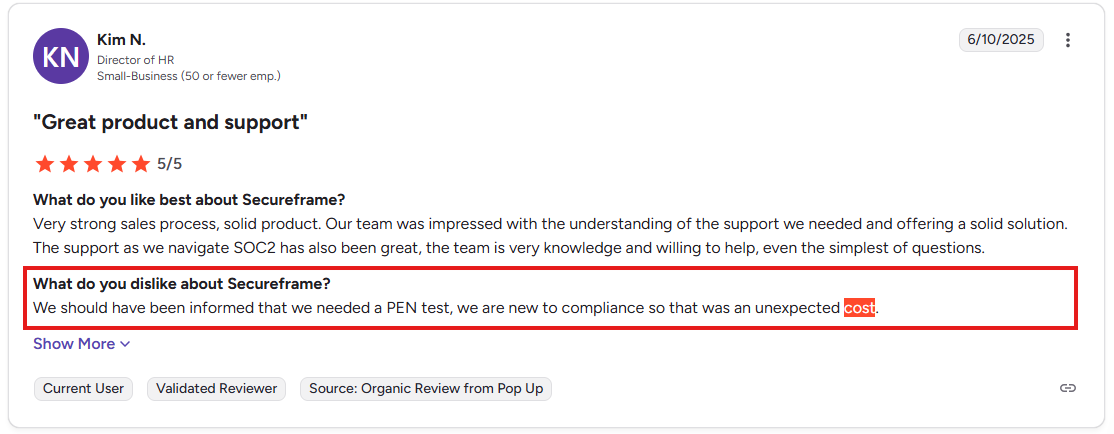
Here’s the pros and cons overview that sums up everything that the other users have to say:
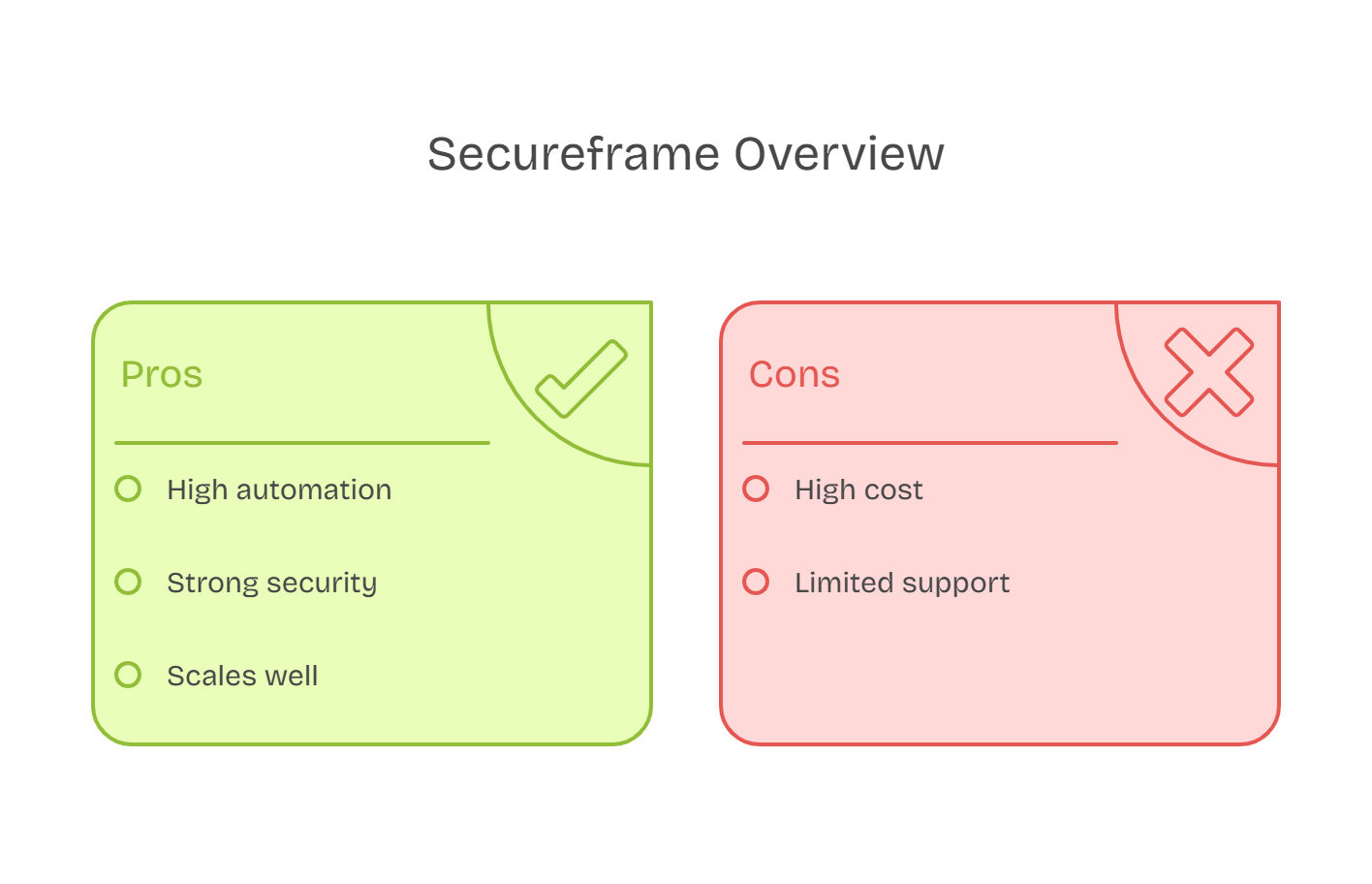
Best Fit Use Case
Security teams that want to unify compliance and vulnerability workflows inside one interface.
Secureframe vs Vanta
Secureframe goes deeper into security infrastructure and integrations. Vanta is faster for early teams but hits the ceiling faster. Secureframe works better if you’ve got a security-first mindset and multiple frameworks in flight.
You need Secureframe if:
You’re scaling quickly and want out-of-the-box coverage for most major frameworks.
AuditBoard – Best for Mature Teams Managing Risk at Scale
Automation Depth
Purpose-built for risk, audit, and internal controls. Automates workflows for audit trails, policy updates, risk tracking, and evidence collection.
Framework Coverage
Supports multiple frameworks across SOC 2, ISO 27001, GDPR, and internal controls. Built for enterprises, not startups.
Integrations
Plays well with ERP, GRC, and ticketing tools like SAP, Workday, Jira, and ServiceNow. API support is robust, but setup is heavier.
Audit-Readiness
Packed with tools for audit collaboration, cross-team tasking, and remediation tracking. Built for auditors and large compliance teams.
Pricing Transparency
No public pricing, but the price range is around $20,000 - $50,000/year. Enterprise-level quotes only. Expect a premium starting point and customization costs.
UX & Support
Interface leans toward structured teams. Learning curve is real but manageable. Enterprise support is strong.
Here’s the pros and cons overview that sums up everything that the users have to say:
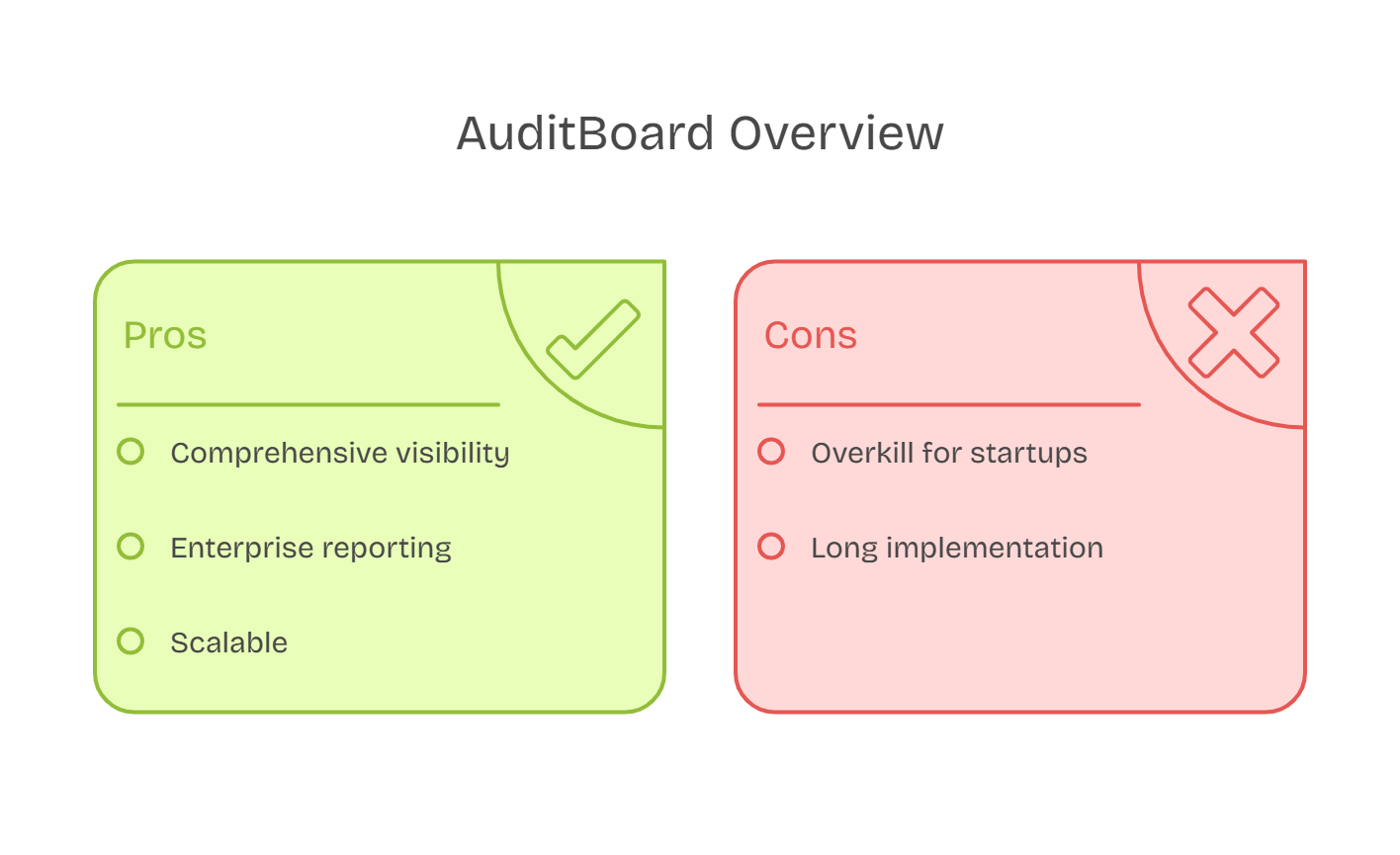
Best Fit Use Case
Large organizations with dedicated audit and risk teams. Ideal when compliance lives across departments.
AuditBoard vs Vanta
Vanta moves fast for early-stage teams. AuditBoard is what you graduate to when risk governance becomes board-level. They solve different stages of the same problem.
You need AuditBoard if:
You’re already doing internal audits and need a tool built around enterprise infosec needs.
OneTrust – Best for Privacy-Centric Compliance Stacks
Automation Depth
Focuses on privacy, governance, and risk. Automates DPIAs, consent tracking, and privacy rights workflows. Limited automation for audit frameworks like SOC 2.
Framework Coverage
Strong in GDPR, CCPA, and global privacy laws. Supports ISO 27701 and privacy risk assessments. Lacks full support for SOC 2 or HIPAA unless layered with GRC modules.
Integrations
Deep integrations with privacy tech, consent managers, and enterprise platforms. Not geared toward DevOps or cloud infrastructure.
Audit-Readiness
Better at privacy program management than classic audit readiness. GRC modules help, but are sold separately.
Pricing Transparency
Pricing is opaque but approximately ranges $9,925 - $100,000+/year. Modular, quote-based, and highly variable depending on use case and geography.
UX & Support
The interface is robust but complex. Support is helpful, but mostly for privacy/legal teams rather than tech-focused users.
Here’s the pros and cons overview that sums up everything that the users have to say:
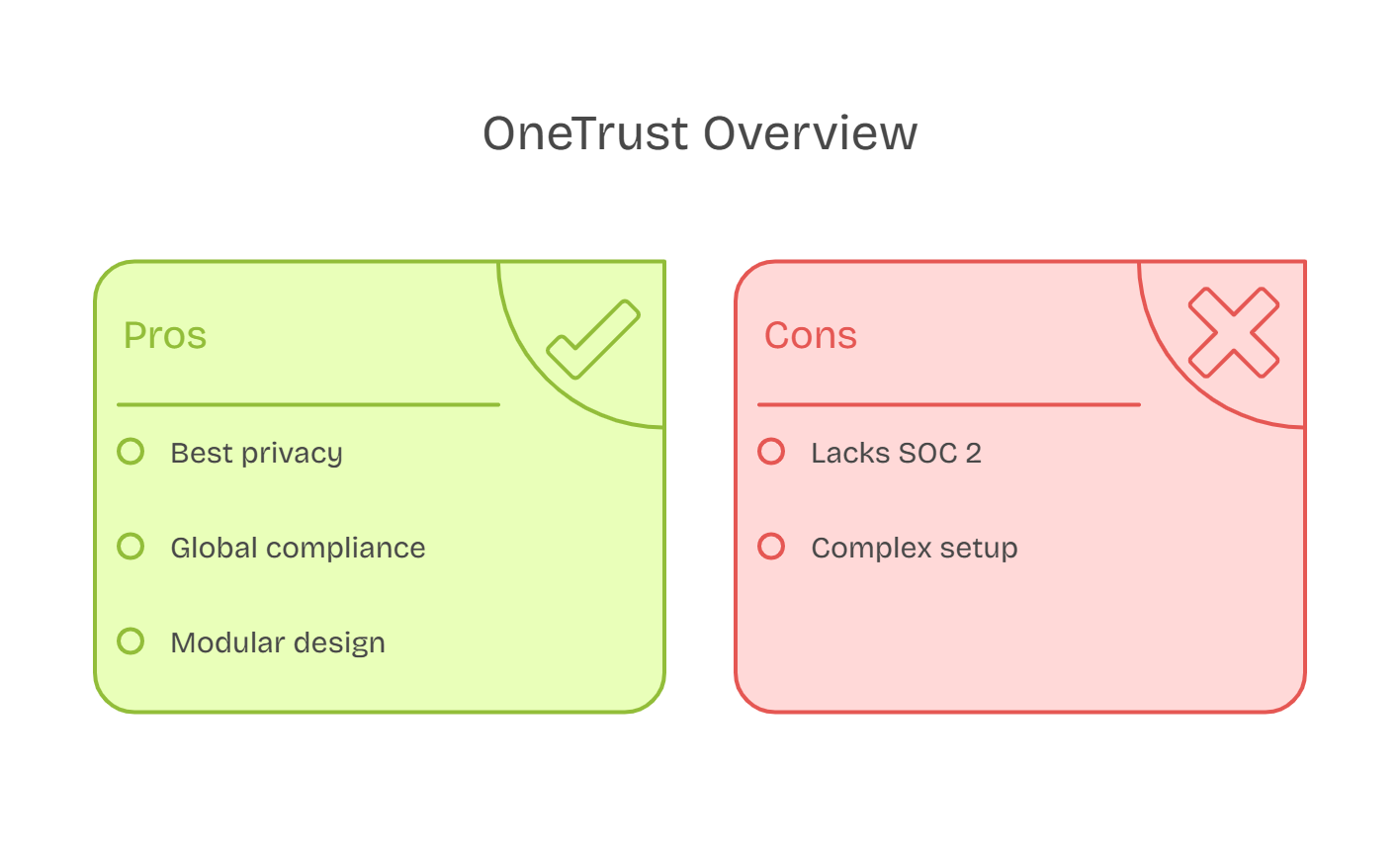
Best Fit Use Case
Privacy-focused orgs that need to handle data subject rights, cookie consent, and cross-border regulation.
OneTrust vs Vanta
If privacy is your biggest compliance pain, OneTrust gets you there. Vanta is still stronger at SOC 2 and security frameworks. The two work best together if you need both.
You need OneTrust if:
You manage GDPR, CCPA, or ESG workflows alongside security and want everything in one dashboard.
Hyperproof – Best for Managing Controls Across Teams
Automation Depth
Hyperproof automates evidence collection, control mapping, and policy tracking. Strong on recurring tasks and audit follow-through. More workflow-focused than trigger-based automation like Drata or Scrut.
Framework Coverage
Supports over 50 frameworks, including SOC 2, ISO 27001, NIST, FedRAMP, and custom ones. Good for teams managing overlapping standards across departments.
Integrations
Integrates with Jira, Slack, Microsoft Teams, AWS, Azure, and GitHub. You can link tickets directly to controls and sync task status in real time.
Audit-Readiness
Offers audit project plans, control health dashboards, and auditor access portals. Built for recurring audits and internal control owners. You can reuse control evidence across multiple audits.
Pricing Transparency
Pricing is quote-based. Not public. Cost grows with users, frameworks, and features. Typically suited for mid-size to large teams.
UX & Support
Clean UI, especially in dashboards and evidence workflows. Customer success is responsive, and onboarding support is hands-on.
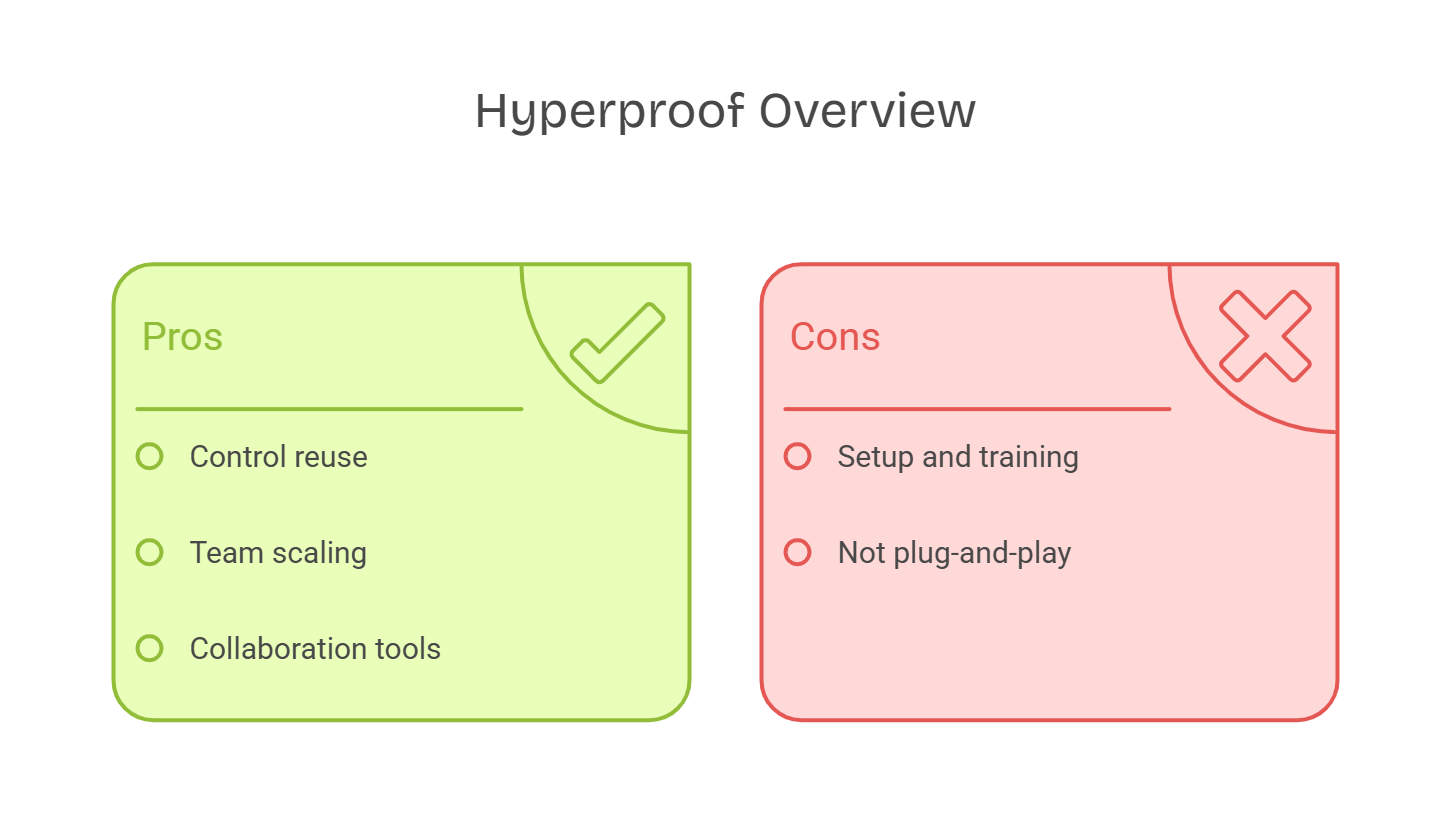
Best Fit Use Case
Mid-market to enterprise teams with recurring audits and distributed control ownership.
Hyperproof vs Vanta
Vanta is ideal for speed to first audit. Hyperproof fits once you’re juggling multiple frameworks or cross-functional compliance teams.
You need Hyperproof if:
You want customizable remediation and real-time audit visibility tied into your workflows.
ISMS.online – Best for ISO-First Compliance Programs
Automation Depth
Focused on ISO 27001 and related controls. Offers guided workflows for risk treatment, documentation, and corrective actions. Automation is light. It’s more about structure and templates than integrations.
Framework Coverage
Strong support for ISO 27001, 27701, and GDPR. Supports SOC 2, but as an add-on. Built for ISO-led compliance journeys.
Integrations
Minimal native integrations. You manage evidence manually or through uploads. Not ideal for cloud-native teams needing API-based control checks.
Audit-Readiness
Offers full ISMS documentation, audit logs, and pre-built reports. You can collaborate with internal teams and external auditors inside the platform.
Pricing Transparency
Packages start around $3,000/year. Clear pricing tiers based on frameworks and user seats. No hidden charges.
UX & Support
The interface is structured, with ISO-aligned language. There’s a learning curve if you’re coming from security-led compliance. Support is helpful and available by region.
Here’s the pros and cons overview that sums up everything that the users have to say:
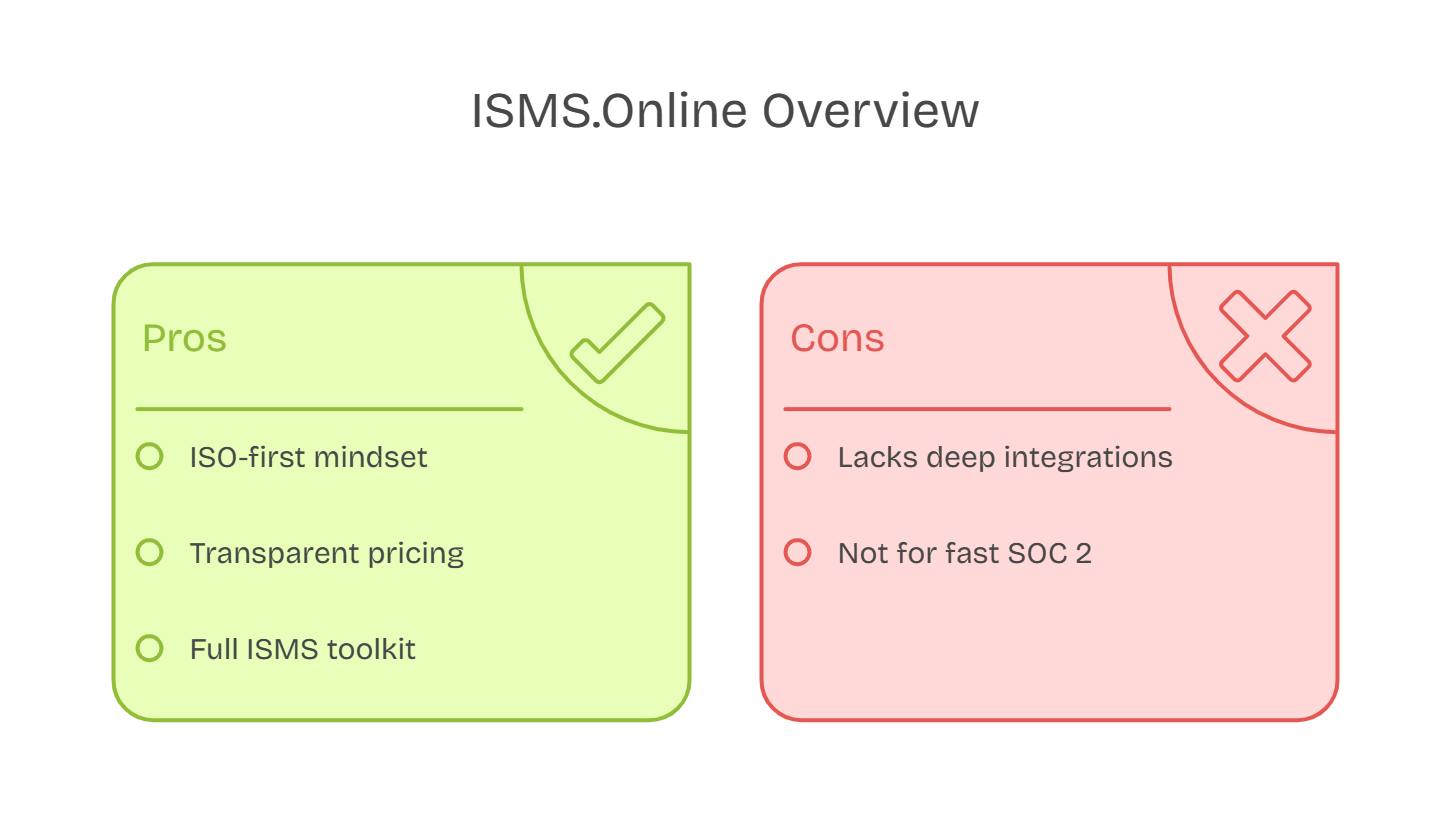
Best Fit Use Case
Organizations with ISO 27001 as the primary compliance driver. Especially common in Europe and B2G SaaS.
ISMS.online vs Vanta
Vanta automates SOC 2. ISMS.online codifies ISO frameworks. If your auditor speaks ISO before anything else, start here.
You need ISMS.online if:
You’re focused on ISO frameworks and want more structure than style.
Strike Graph – Best for Simplified Audit Project Management
Automation Depth
Strike Graph keeps automation light. It focuses more on guiding users through audit prep than automating every control. It does help streamline evidence collection, but it does not offer continuous control monitoring like Drata or Scrut.
Framework Coverage
Strong for SOC 2, ISO 27001, and HIPAA. FedRAMP and PCI are available on request. Good starting point for growing teams with limited compliance experience.
Integrations
Basic integrations with cloud platforms, HR systems, and ticketing tools. You will need to manually configure some connections. Expect CSVs and uploads for certain workflows.
Audit-Readiness
This is where it shines. Strike Graph turns audits into a clear project plan with tasks, evidence uploads, and checklists. It simplifies what can otherwise feel like herding cats.
Pricing Transparency
Pricing starts around $10,000 per year. Pricing structure is clear across tiers but grows with frameworks. Less markup than larger vendors.
UX & Support
The interface is simple and task-driven. Ideal for lean teams without a compliance manager. Support is responsive and includes guided onboarding.
Here’s the pros and cons overview that sums up everything the users have to say:
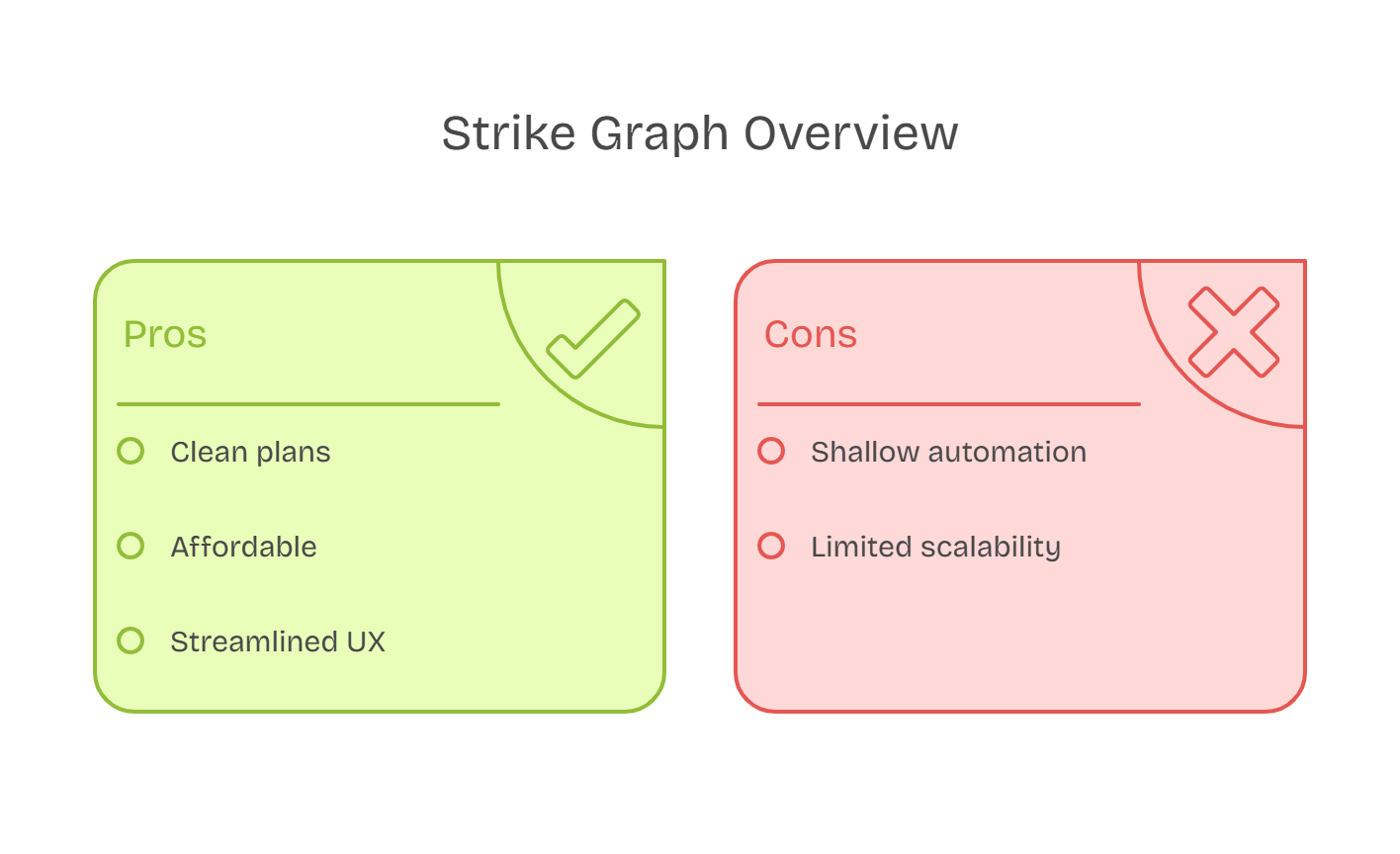
Best Fit Use Case
Startups doing their first SOC 2 or ISO 27001 with minimal in-house compliance experience.
Strike Graph vs Vanta
Vanta wins on automation. Strike Graph focuses on clarity and simplicity. If we wanted a no-fuss audit process without deep integrations, we’d pick Strike Graph.
You need Strike Graph if:
You want fast SOC 2 and real support from humans who’ve done it before.
Oneleet – Best for All-in-One Security Stack with Compliance
Automation Depth
Moderate automation. Offers continuous monitoring for basic controls but relies on integrations and manual configuration for deeper workflows. Includes vulnerability scanning and pentesting inside the same platform.
Framework Coverage
Covers SOC 2, ISO 27001, and PCI. Not as broad as Secureframe or Drata, but focused on modern startup needs.
Integrations
Hooks into GitHub, AWS, GCP, Jira, and more. Some integrations are still maturing. Evidence syncing is reliable but not as granular as legacy tools.
Audit-Readiness
Bundled pentest and audit features are useful. It shortens the vendor list and combines security ops and compliance under one roof. You can track controls, gaps, and security findings in one place.
Pricing Transparency
Transparent pricing on the site. Starts at $5,000/year with included pentest. That’s rare and valuable for lean security teams.
UX & Support
Modern UI. The setup feels guided and less rigid than older tools. Support is solid, especially for early-stage teams.
Here’s the pros and cons overview that sums up everything the users have to say:
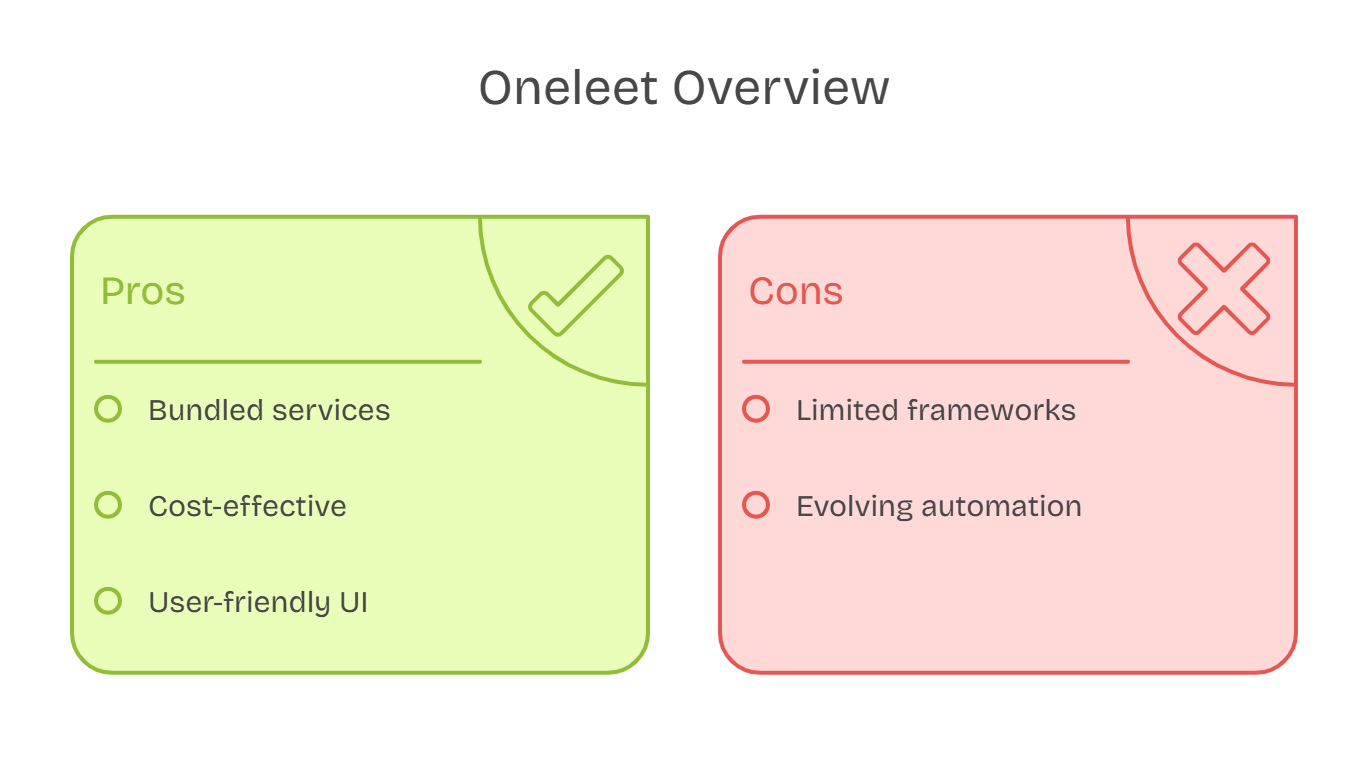
Best Fit Use Case
Seed to Series A teams looking for a bundled solution with security tooling and compliance workflows in one place.
Oneleet vs Vanta
If we needed SOC 2 plus a pentest and didn’t want to manage multiple vendors, Oneleet would win. Vanta automates more but doesn’t include security testing.
You need Oneleet if:
You want penetration testing bundled with compliance, especially if your team is development-heavy.
TrustCloud – Best for Early Teams Needing Risk + Compliance
Automation Depth
Offers a reasonable level of control, tracking, and evidence automation. Not as deep as Scrut or Drata, but reliable for small teams starting out. Also includes risk register workflows and policy assignments.
Framework Coverage
SOC 2, ISO 27001, and HIPAA covered. Supports NIST CSF and GDPR as optional modules. Coverage is solid but limited for highly regulated verticals.
Integrations
Covers the basics: AWS, Google Workspace, Okta, GitHub, and Slack. Real-time control checks are available, though some systems still require manual verification.
Audit-Readiness
Includes pre-built policy templates, control mapping, and auditor collaboration features. You can prep for audits without downloading endless spreadsheets.
Pricing Transparency
Offers freemium plans for early-stage companies. Paid tiers start at around $4,000/year. Clear tiered pricing helps avoid billing surprises.
UX & Support
Intuitive dashboard, especially for risk and policy management. Chat support is quick, and onboarding is smooth for early users.
Here’s the pros and cons overview that sums up everything the users have to say:
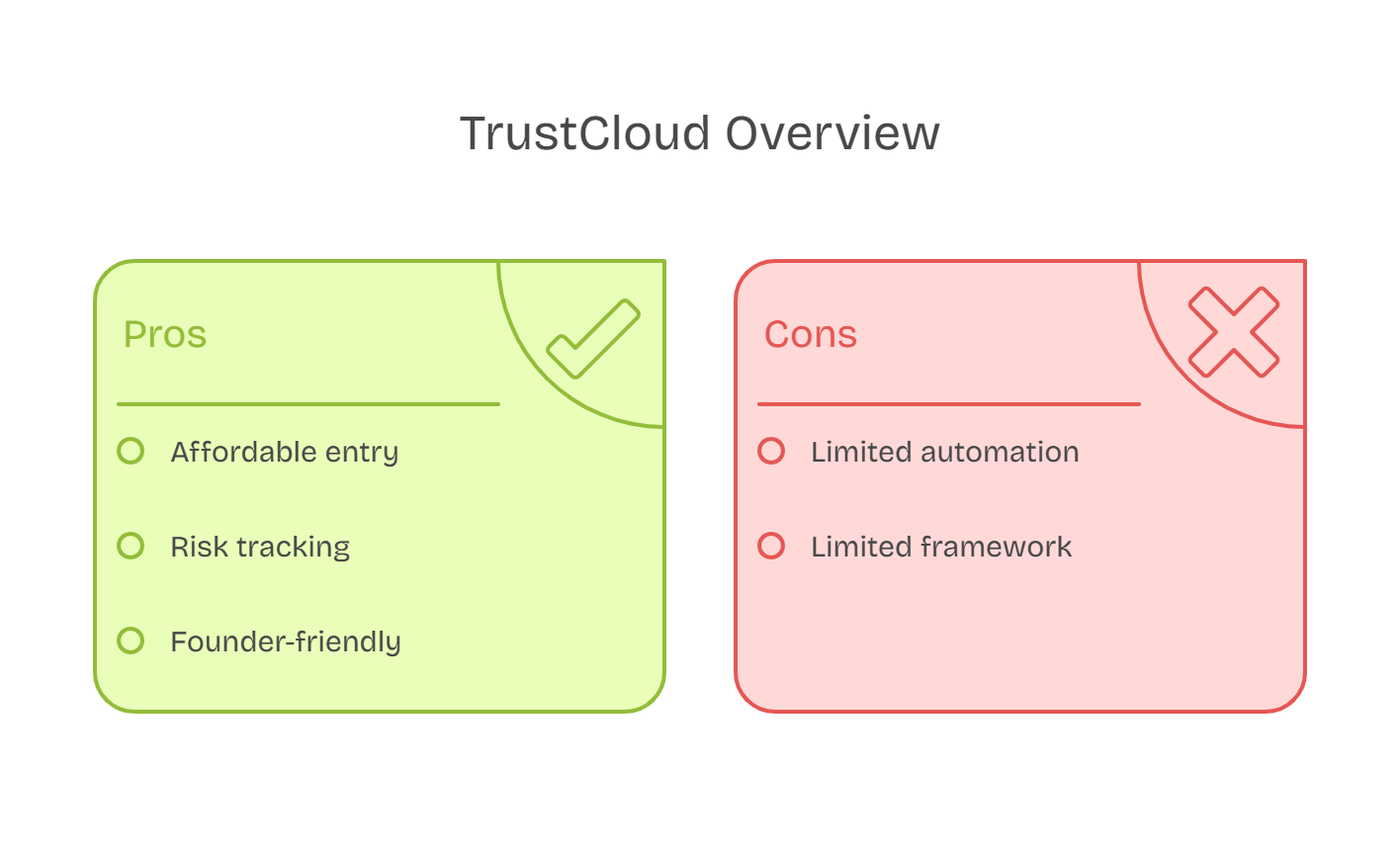
Best Fit Use Case
Startup founders running SOC 2 themselves with minimal headcount or security ops.
TrustCloud vs Vanta
TrustCloud trades automation for simplicity. If we were a seed-stage company needing risk, policy, and compliance help in one place, TrustCloud would get us off the ground fast.
You need TrustCloud if:
You want compliance tied into sales, security reviews, and customer trust signals.
Scrut – Best for Risk-Led Compliance
Automation Depth
Scrut runs deep. It automates real-time control testing, policy enforcement, asset monitoring, and evidence workflows. The risk module ties it all together.
Framework Coverage
Supports 50+ frameworks including SOC 2, ISO 27001, PCI DSS, HIPAA, GDPR, and NIST. Pre-mapped controls make switching frameworks frictionless.
Audit-Readiness
Customizable policy templates, live control dashboards, and an auditor portal built into the platform. Keeps audit prep ongoing instead of last-minute.
Pricing Transparency
No public pricing. Requires a call. Ask for an exact framework-wise breakdown upfront.
UX & Support
Designed for fast-moving teams. Clean layout, fast onboarding, and responsive Slack-based support.
Customers expect improved support, as highlighted by this verified Scrut user:
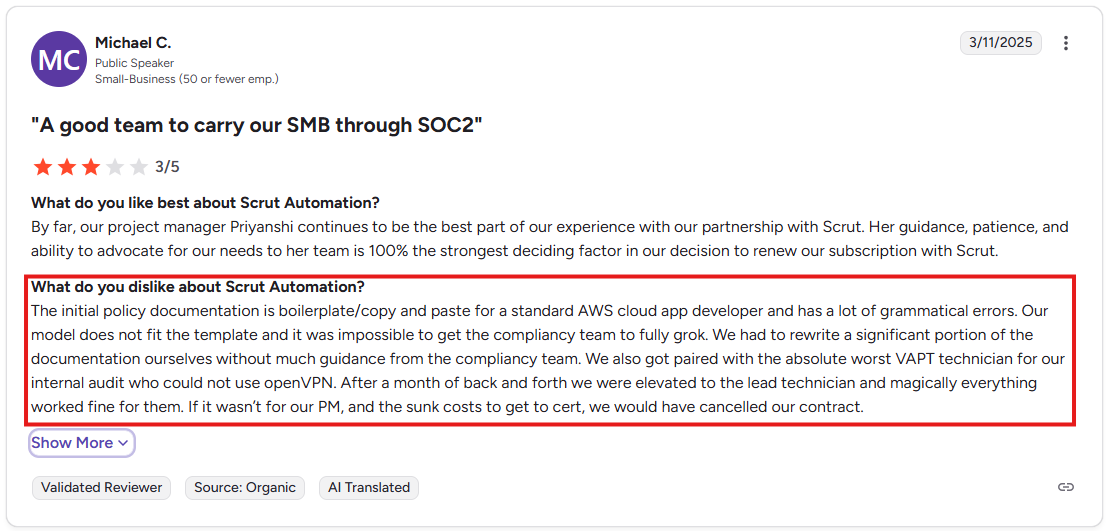
Here’s the pros and cons overview that sums up everything the users have to say:
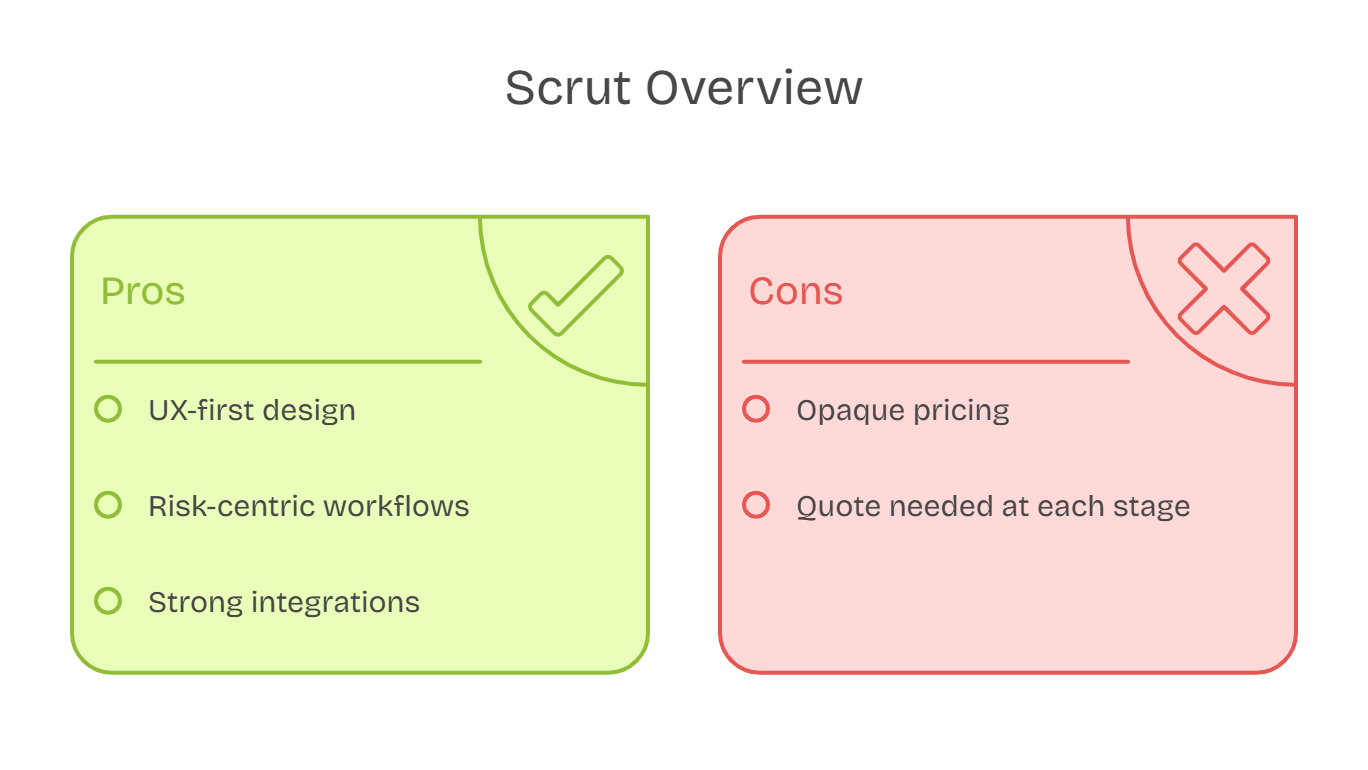
Best Fit Use Case
Growing GRC teams managing multi-framework compliance who want deep visibility without spreadsheet chaos.
Scrut automation vs Vanta
Scrut handles framework overlap and risk workflows better. Vanta is quicker to start but lacks Scrut’s enterprise-readiness once scale kicks in.
You need Scrut if:
You want a cleaner workflow experience and control across multiple standards.
Buyer’s Guide: How to Choose the Right Vanta Alternative
Choosing a compliance platform should feel like hiring the right operator. It needs to match your stage, team workflow, and the frameworks you're taking on. If it adds friction or tries to force a process that doesn’t map to how your team works, it’s the wrong fit.
Use the guide below to make a clean, fast decision based on your size, audit pressure, and regulatory complexity.
Startup vs Mid-Market vs Enterprise: What Actually Changes
Startups (1–50 employees)
You’re sprinting to SOC 2. You don’t need GRC layers. You need audit-ready templates, fast support, and zero sales calls.
Mid-Market (50–250 employees)
You’re running SOC 2 and expanding to ISO or HIPAA. You need tools that can handle layered workflows and team-wide collaboration.
Enterprise (250+ employees)
Compliance is now part of your operating model. Think role-based permissions, audit logs, internal reviews, and GRC tracking.
Industry-Specific Fit
FinTech
Look for platforms that support PCI-DSS, ISO 27001, and vendor risk workflows out of the box.
SaaS
You’ll need GitHub, AWS, and Jira integrations that don’t break during audits. Bonus if the tool helps close deals faster.
HealthTech
HIPAA support is mandatory. Make sure the tool respects data access workflows and provides full audit logs.
Manufacturing
You’ll likely have a hybrid infrastructure. Go with platforms that allow granular monitoring across both cloud and legacy systems.
Shortcut Filter
Frequently Asked Questions (FAQ)
Do Vanta competitors offer free trials?
Most Vanta competitors do not offer standard free trials. However, ComplyJet is a top Vanta alternative that provides a full-featured 21-day free trial, making it easy for businesses to experience compliance automation risk-free before purchasing
How much does Vanta cost compared to competitors?
- Vanta Pricing (2025): Starts at $10,000/year for the Essential plan. Higher tiers, such as Pro and Enterprise, can range from $30,000 to $80,000+ based on team size, framework support, and add-ons.
- Drata: Starts at ~$7,500/year for SOC 2; higher pricing for enterprise use.
These tools are ideal for startups and SMBs needing basic compliance without enterprise-level pricing.
What are the top-rated Vanta alternatives in 2025?
The best alternatives to Vanta in 2025 include:
- Drata: Strong automation and developer integrations
- Secureframe: Multi-framework coverage
- ComplyJet: AI-driven and quick compliance
- Sprinto: Speed-focused audit readiness
What compliance frameworks do Vanta competitors support?
Most Vanta competitors support: SOC 2, ISO 27001, HIPAA, GDPR, PCI DSS, CCPA, NIST, CIS. Some competitors like Scytale, Scrut, and Thoropass support 30+ frameworks across global regions.
Which Vanta competitor is easiest to implement?
- Vanta: Known for quick onboarding and minimal setup
- Drata & EasyAudit: Also offer guided onboarding workflows
- ComplyJet: Offers white-glove onboarding with real-time auditor access
- Open-source tools: Require setup and technical configuration
Is Drata better than Vanta?
Drata offers deeper automation, developer-friendly tools, and better scalability.
Vanta offers faster setup and broader SaaS integrations for small teams.
Choose Drata if automation and scale matter.
Choose Vanta if speed and simplicity are the priority.
Which Vanta competitor offers the most integrations?
- Vanta: Over 375 integrations (HR, SaaS, cloud platforms)
- Drata: 270+ integrations (GitHub, Okta, AWS)
- ComplyJet: AI incorporation with Native integrations with AWS, Azure, Google Workspace, GitHub, Okta, Jira, and Notion.
- Scrut, Sprinto, Secureframe: Also offer 100+ integrations
- Vanta has the widest catalog, but Drata leads in developer stack coverage.
Why do companies switch from Vanta?
Top reasons for switching:
- Lower cost and transparent pricing from competitors
- Advanced automation and AI features
- Better customer support and scaling capabilities
- Broader or more specific framework coverage
- More flexible integration with DevOps and engineering tools
How much does Vanta cost in 2025?
Basic plans begin at $10,000/year, with Pro and Enterprise packages reaching $30,000 to $80,000+, depending on the number of employees, frameworks, and audit add-ons.
Is Vanta a SaaS company?
Yes. Vanta is a SaaS-based compliance automation provider offering cloud solutions for certifications such as SOC 2 and ISO 27001.
What does Vanta do?
Vanta helps companies:
- Monitor security controls
- Automate evidence collection
- Prepare for audits (SOC 2, ISO, HIPAA, etc.)
- Centralized compliance tracking
What kind of software is Vanta?
Vanta is a cloud-based compliance automation tool within the GRC (Governance, Risk, and Compliance) category.
Who competes with Vanta?
Top Vanta competitors include:
- Drata, Secureframe, Scrut Automation, Sprinto
- Scytale, Thoropass
- OneTrust, AuditBoard, LogicGate
Conclusion
Vanta is solid, but it is no longer the default. In 2025, tools like ComplyJet, Drata, and Sprinto outperform it in key areas, including automation, pricing clarity, and support for multiple frameworks.
Depending on where you are, three alternatives stand out:
- ComplyJet — Fast-track SOC 2 with modular pricing and guided setup
- Drata — Strong for growing tech teams managing multiple frameworks
- Scrut — Balanced automation and clean UI for scale-up teams
Here’s the bottom line: pick based on how your team works today, and what frameworks you’ll need next quarter. Fit beats familiarity.
Here’s what to do next:
- Start the ComplyJet free trial to see faster, smarter compliance in action
- Try a free trial from tools like UpGuard or SecurityScorecard
- Use a comparison tool to match features against your exact needs
Start stronger. Scale faster.
.png)


